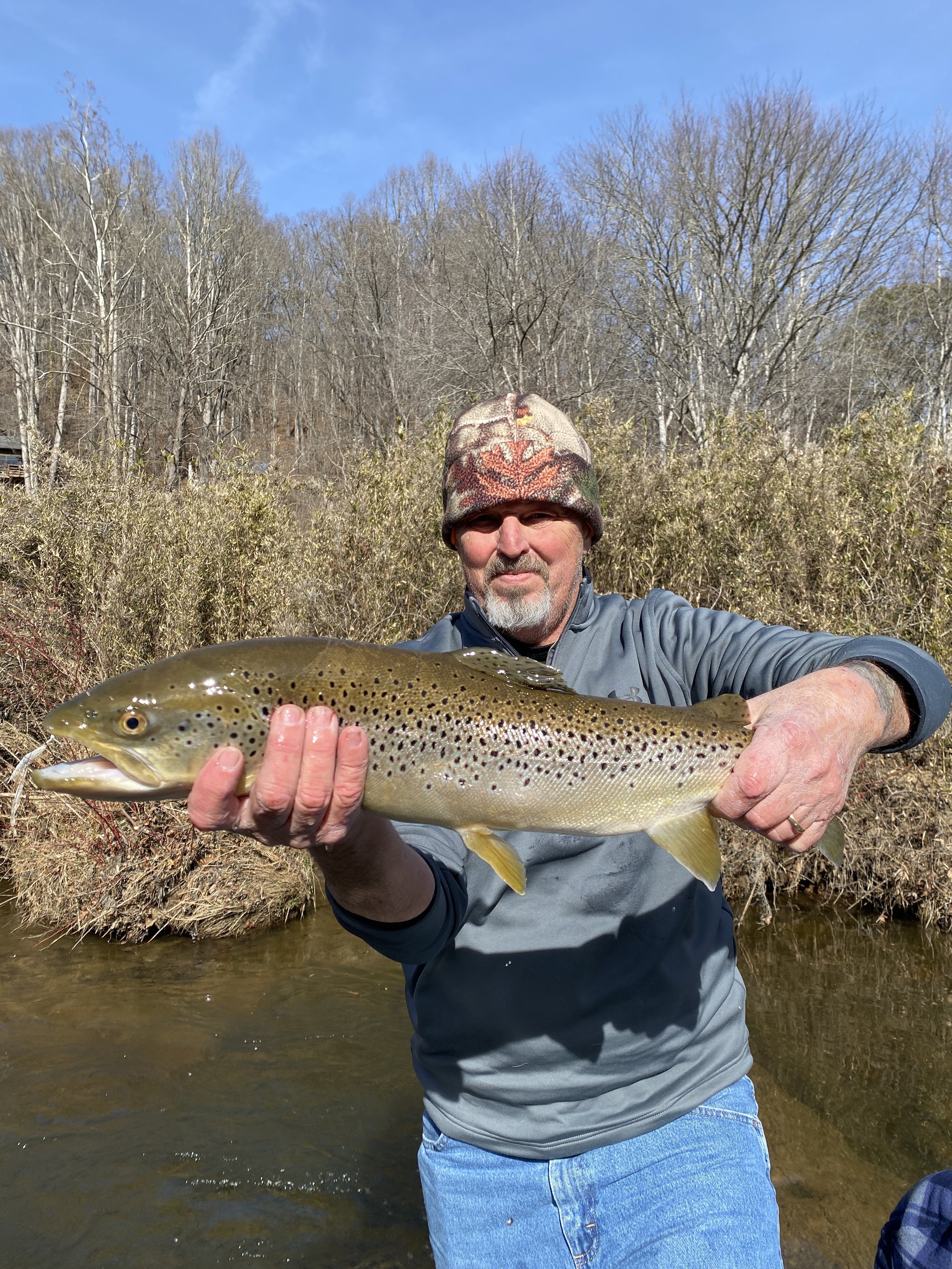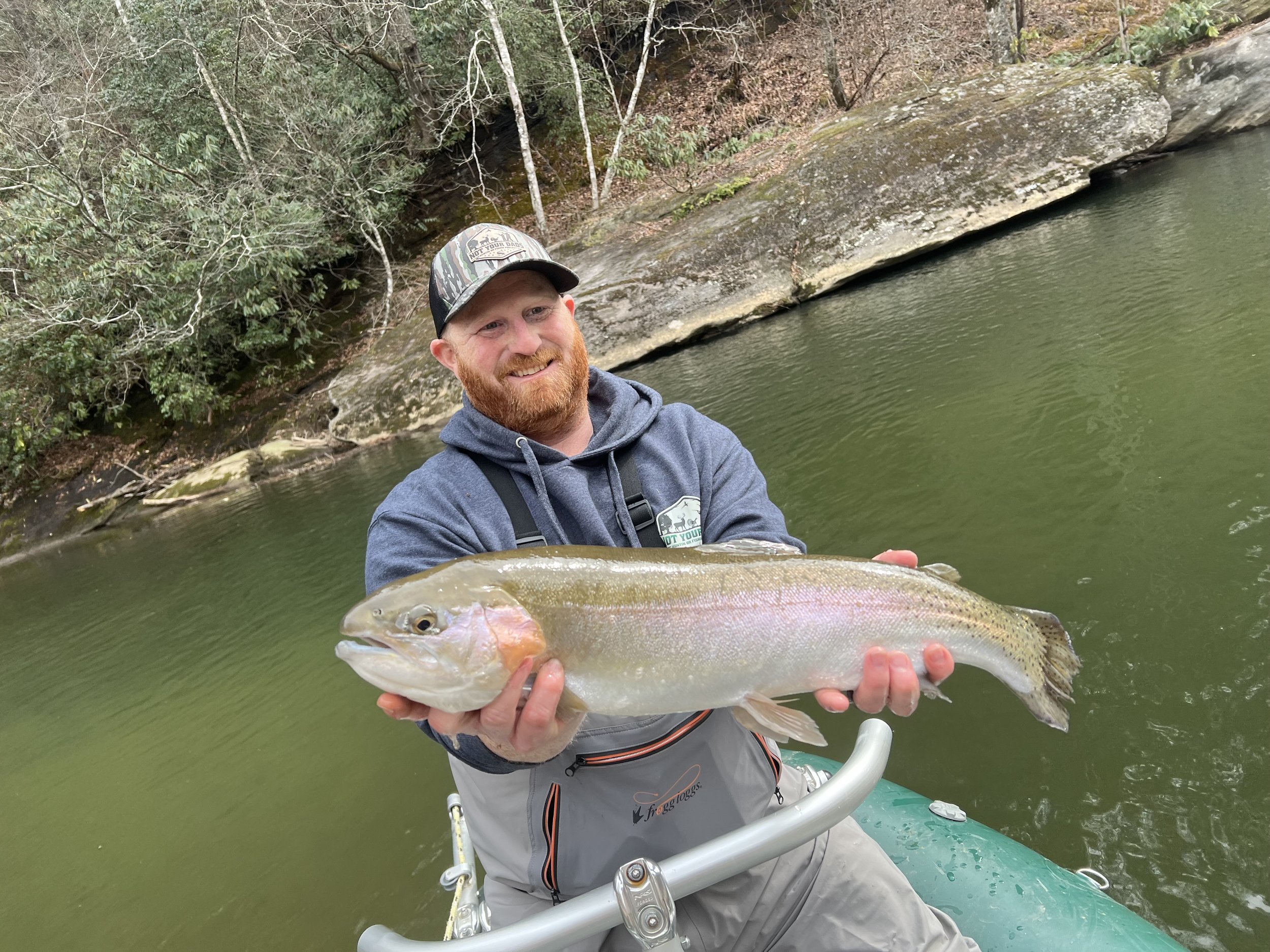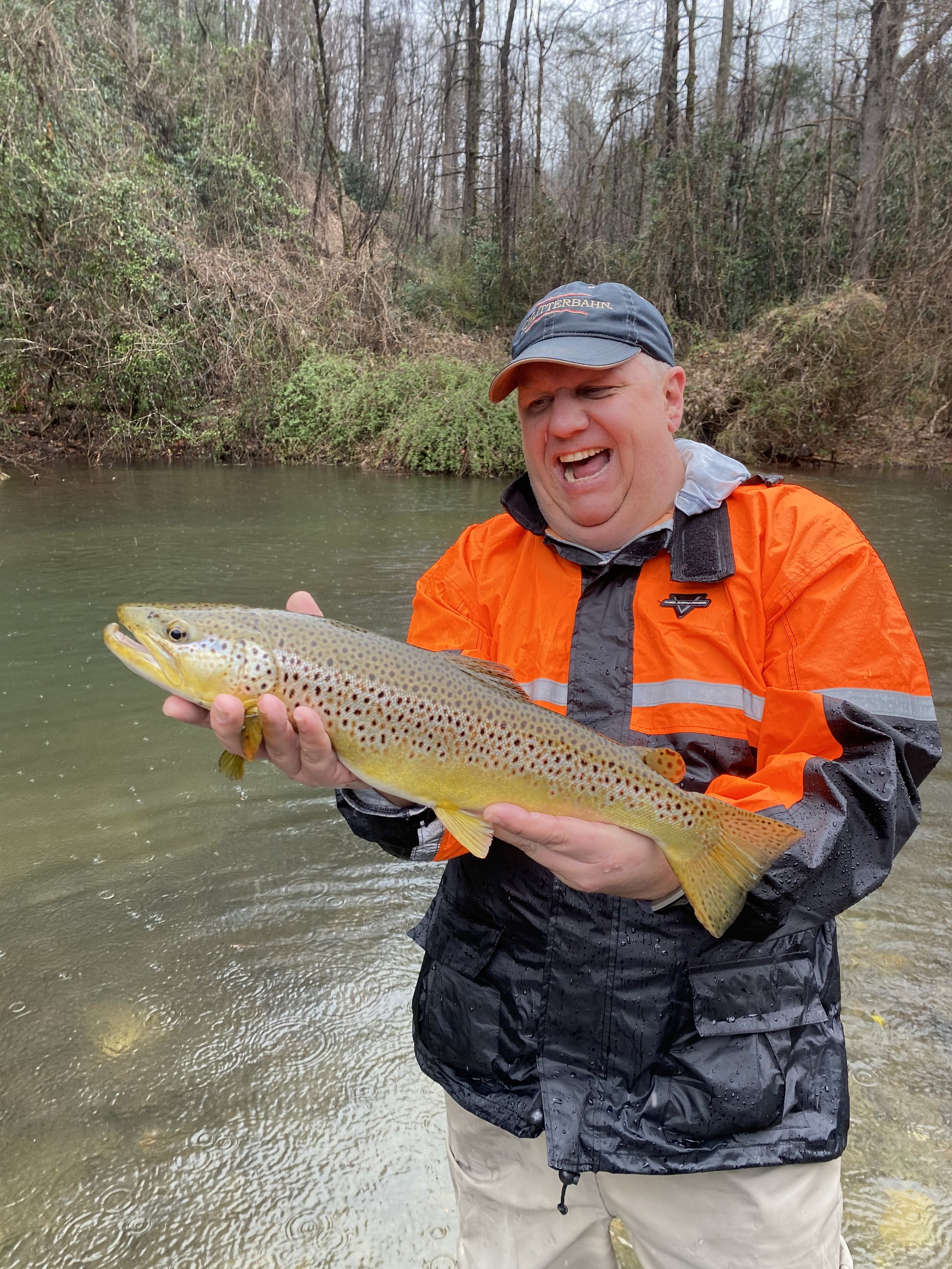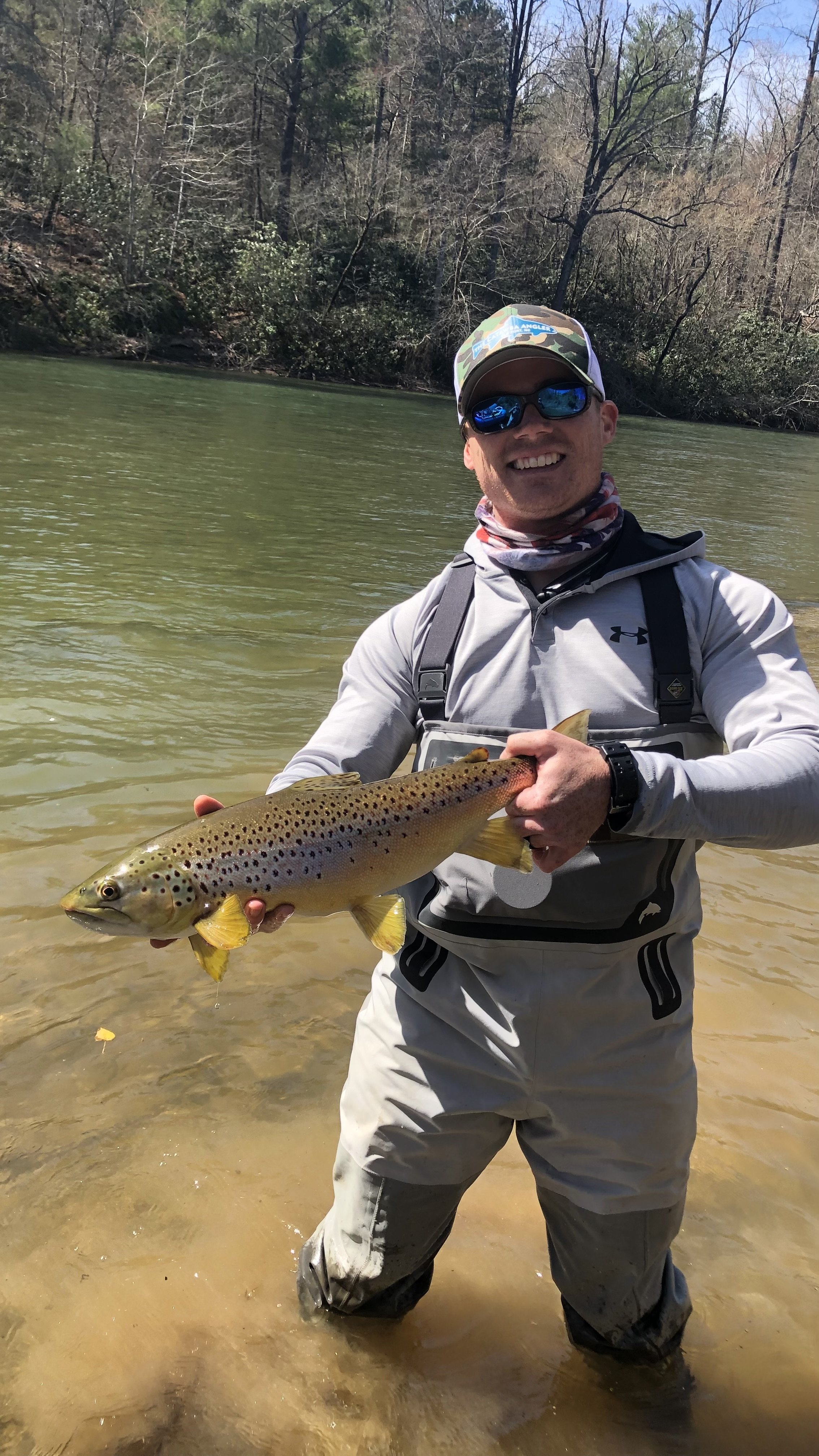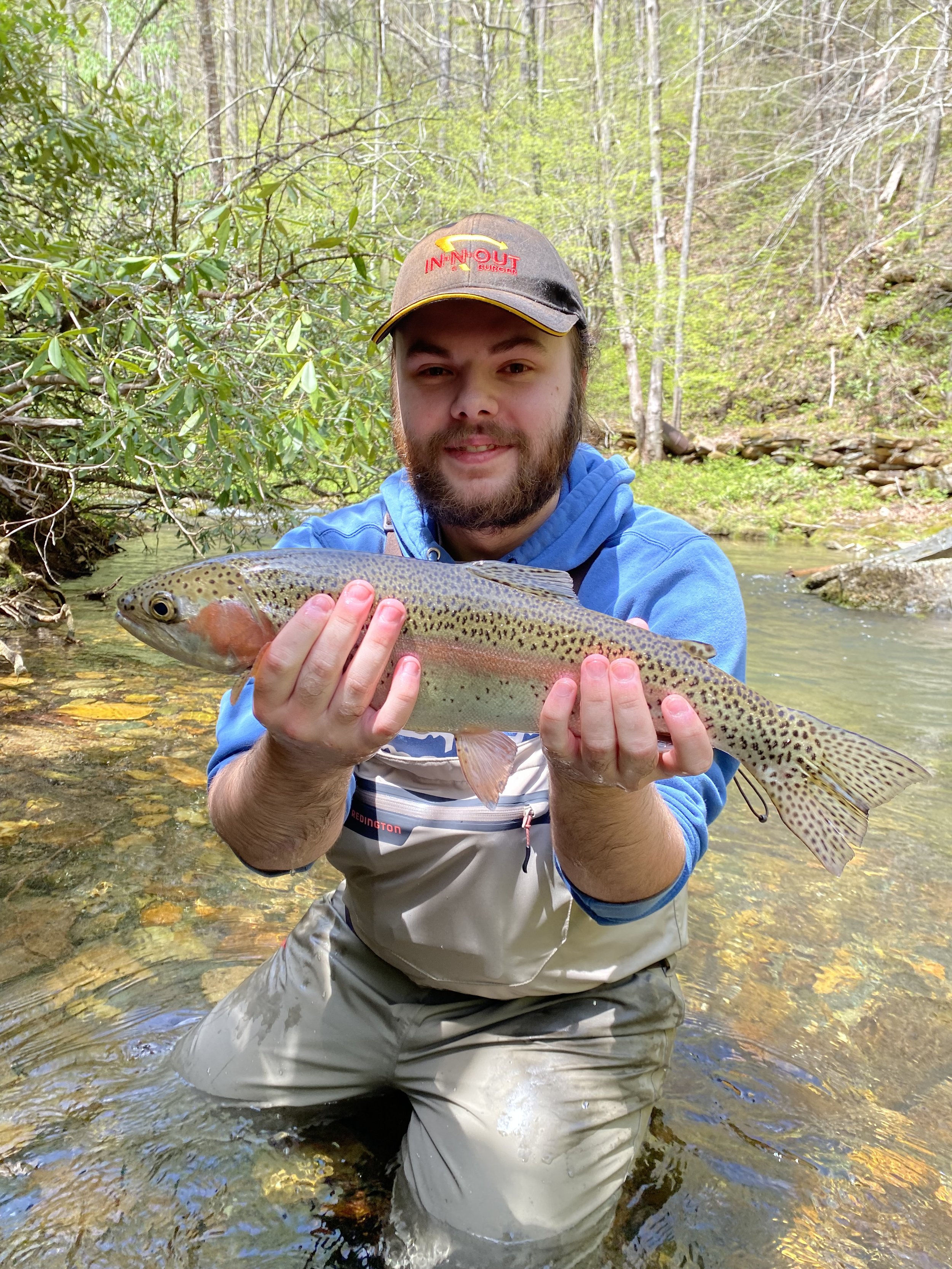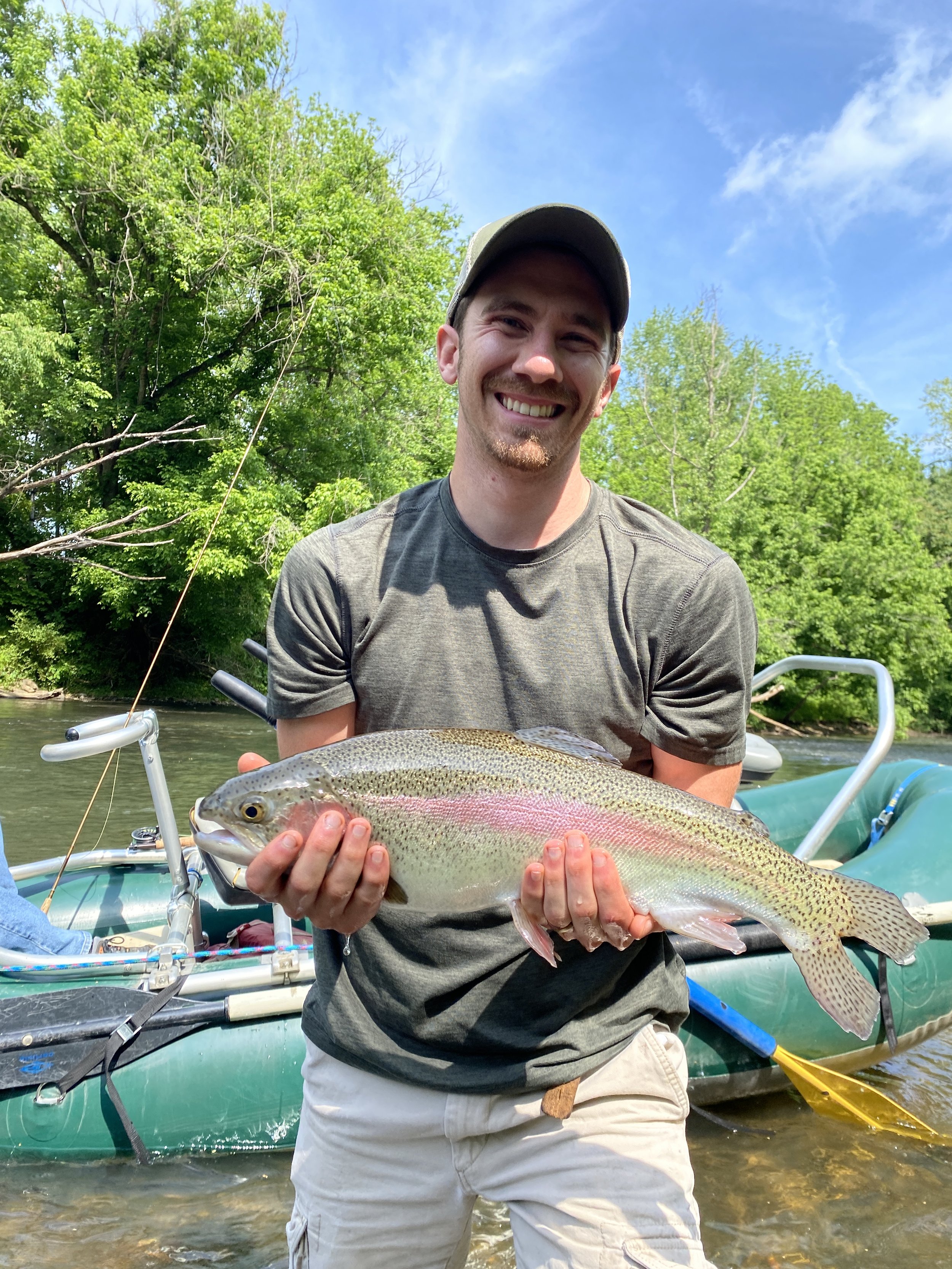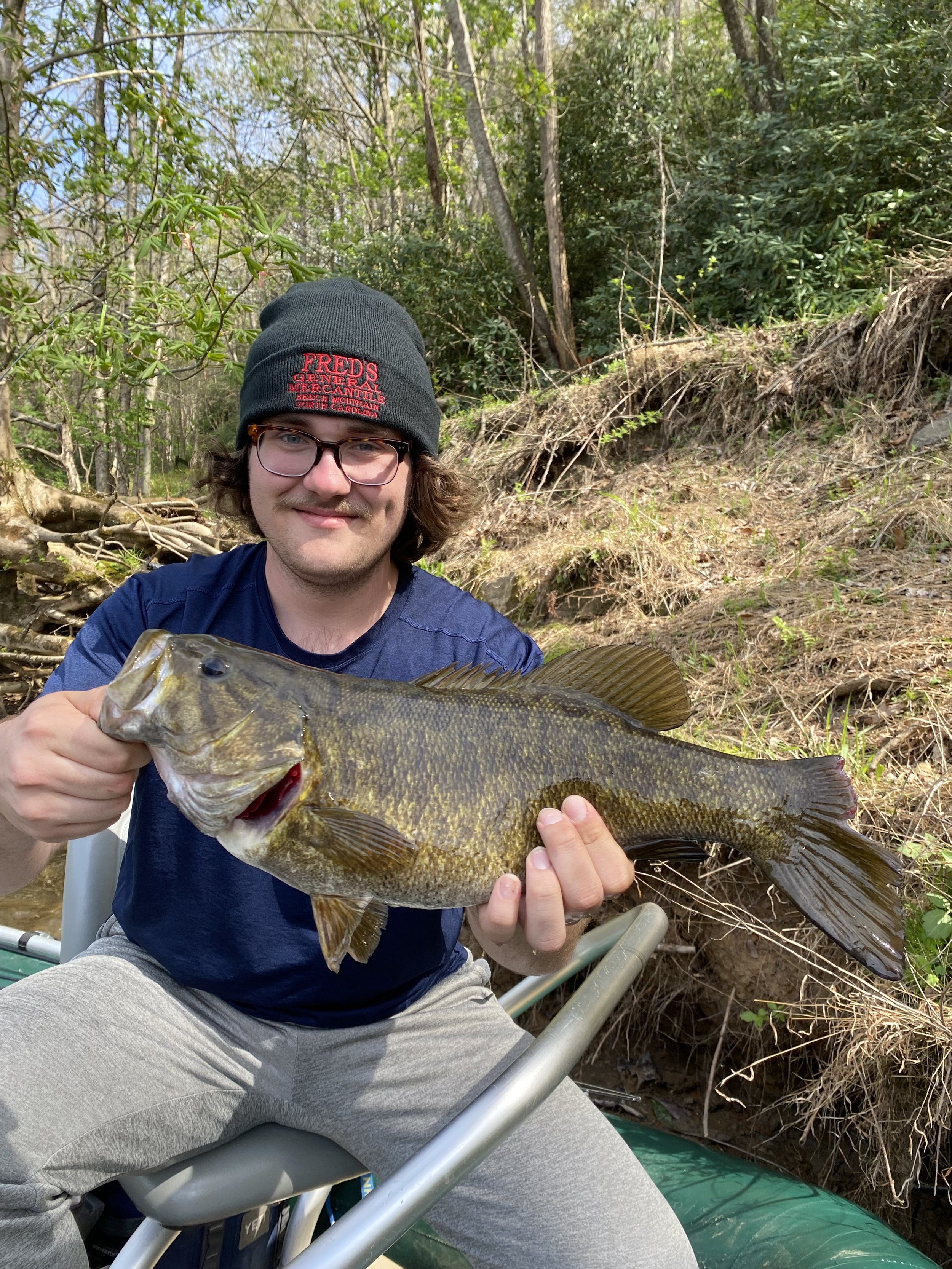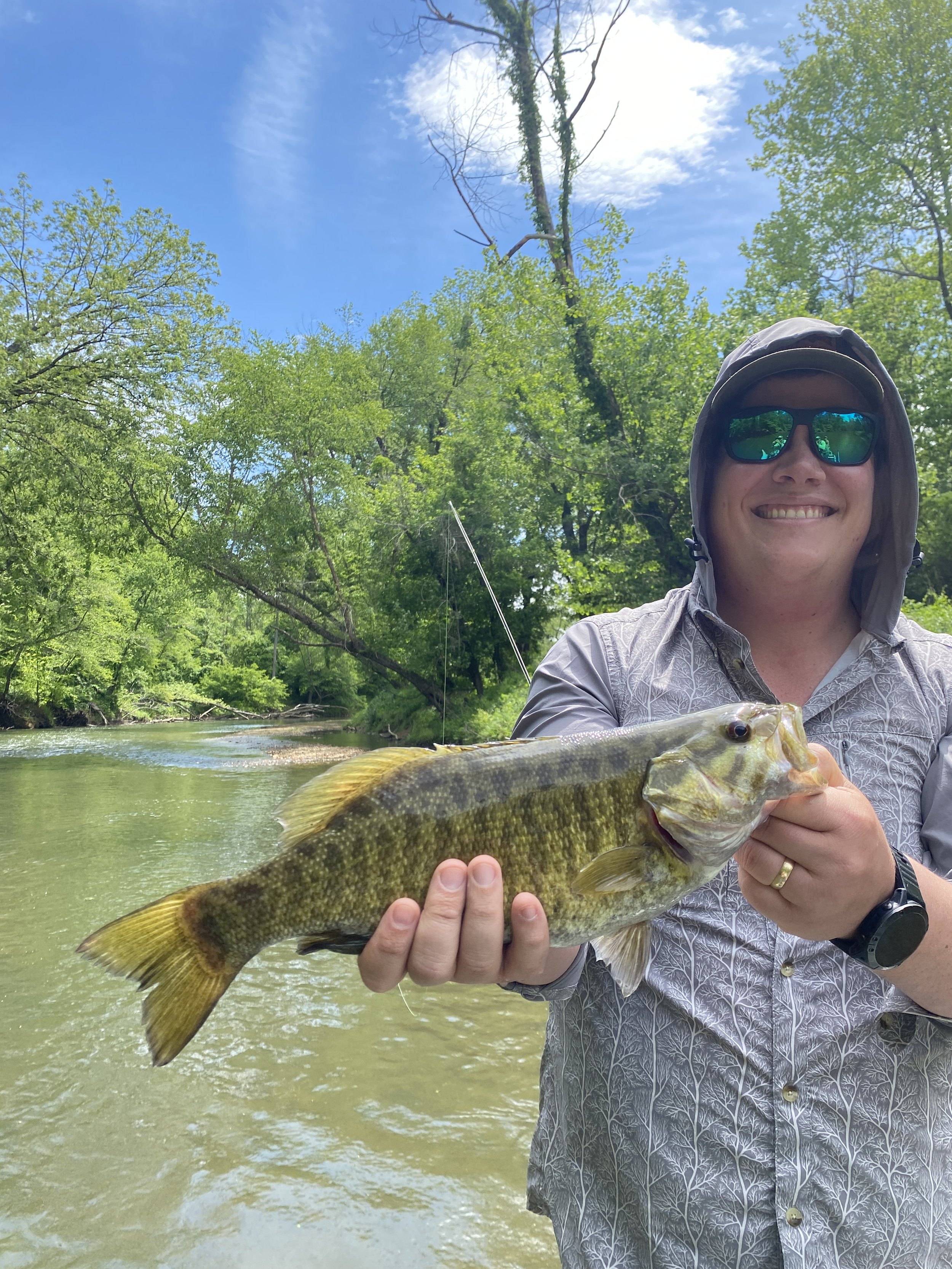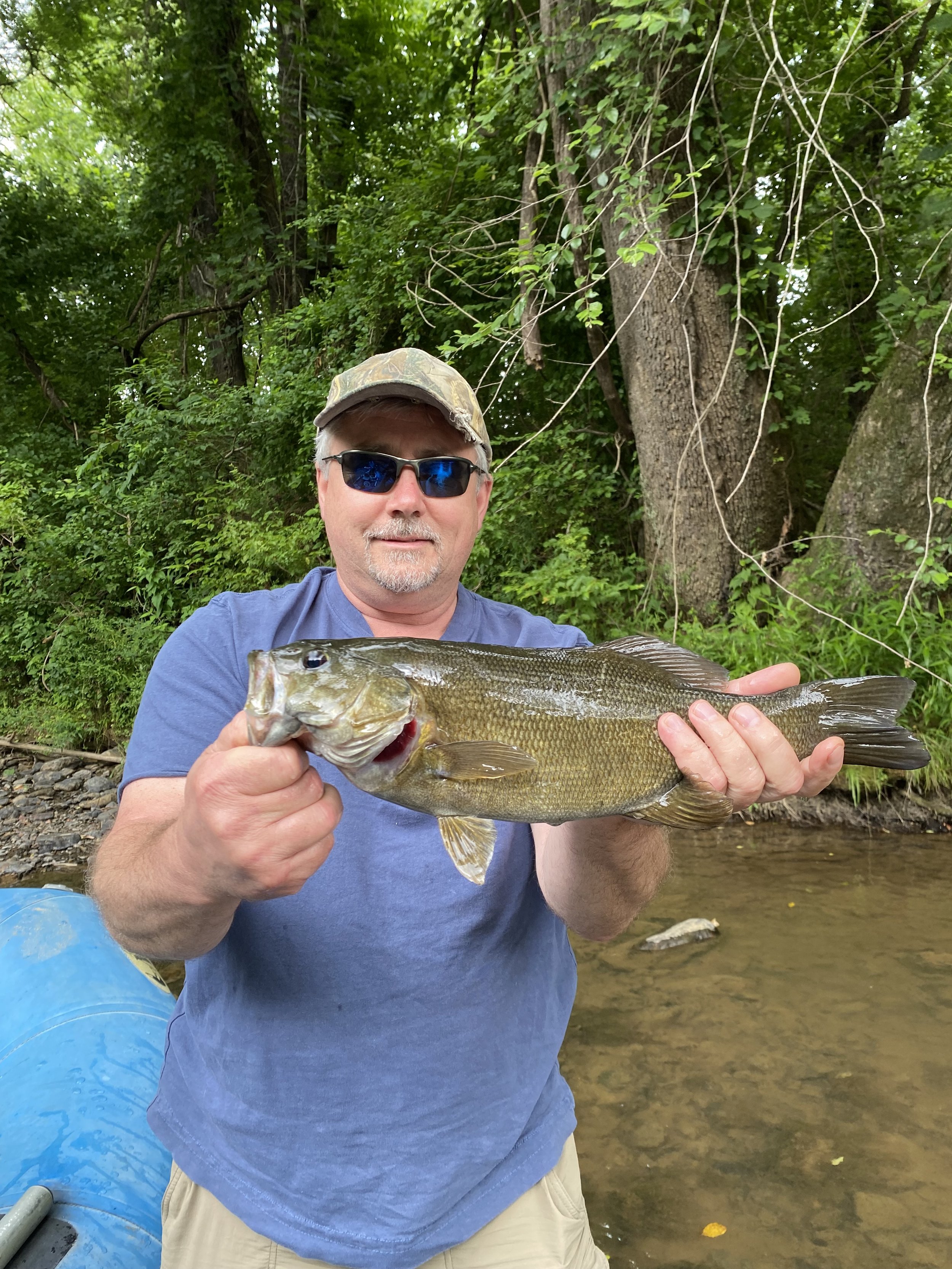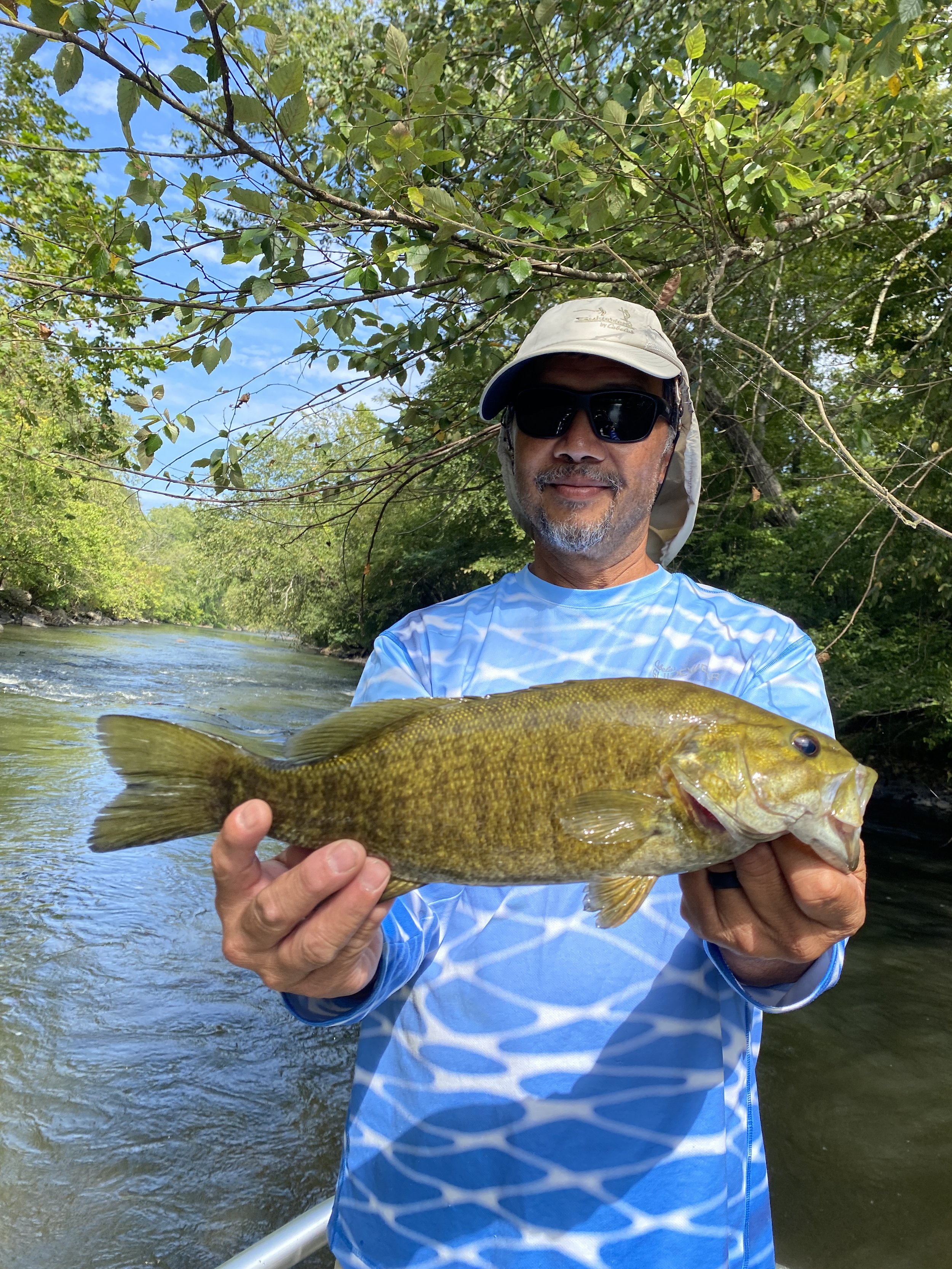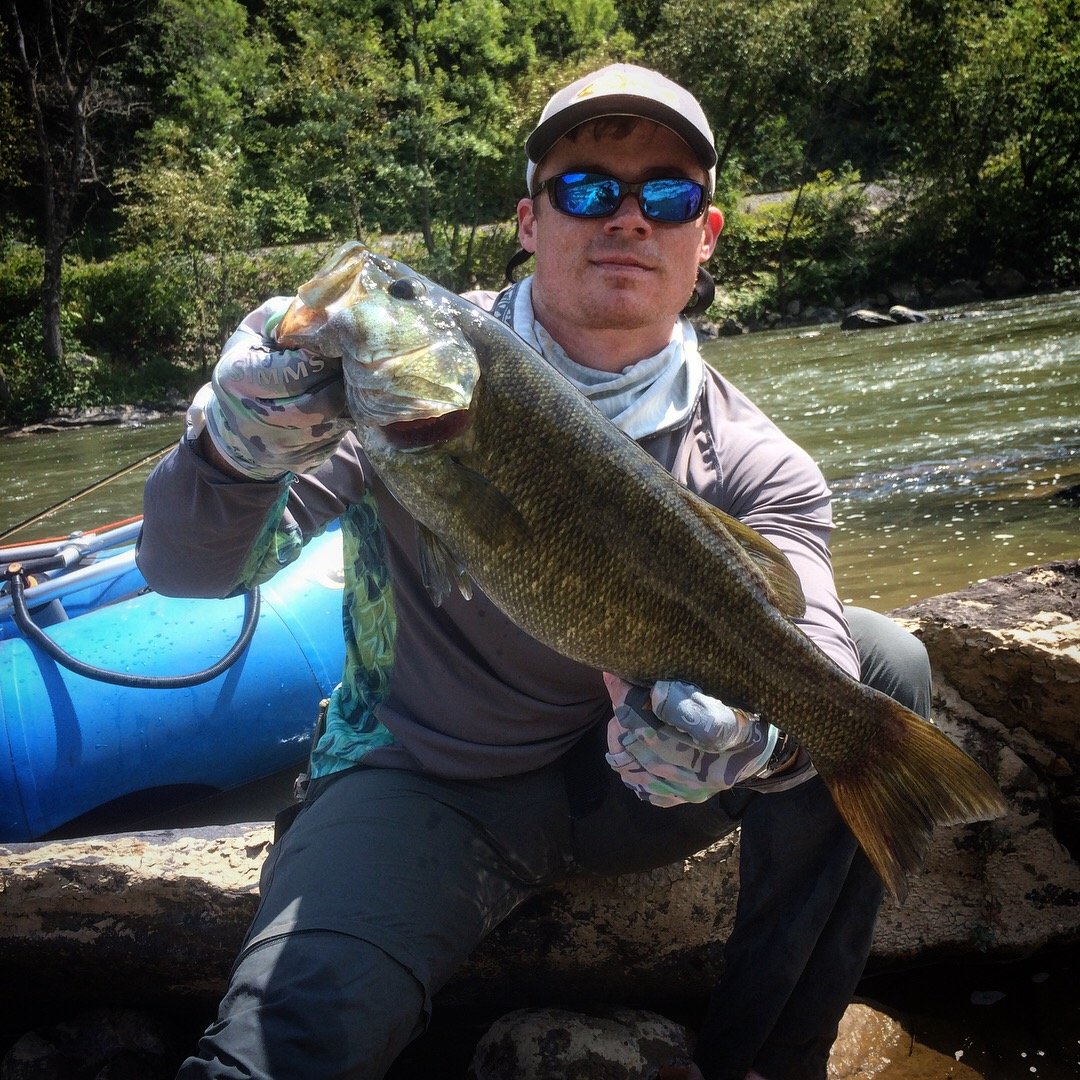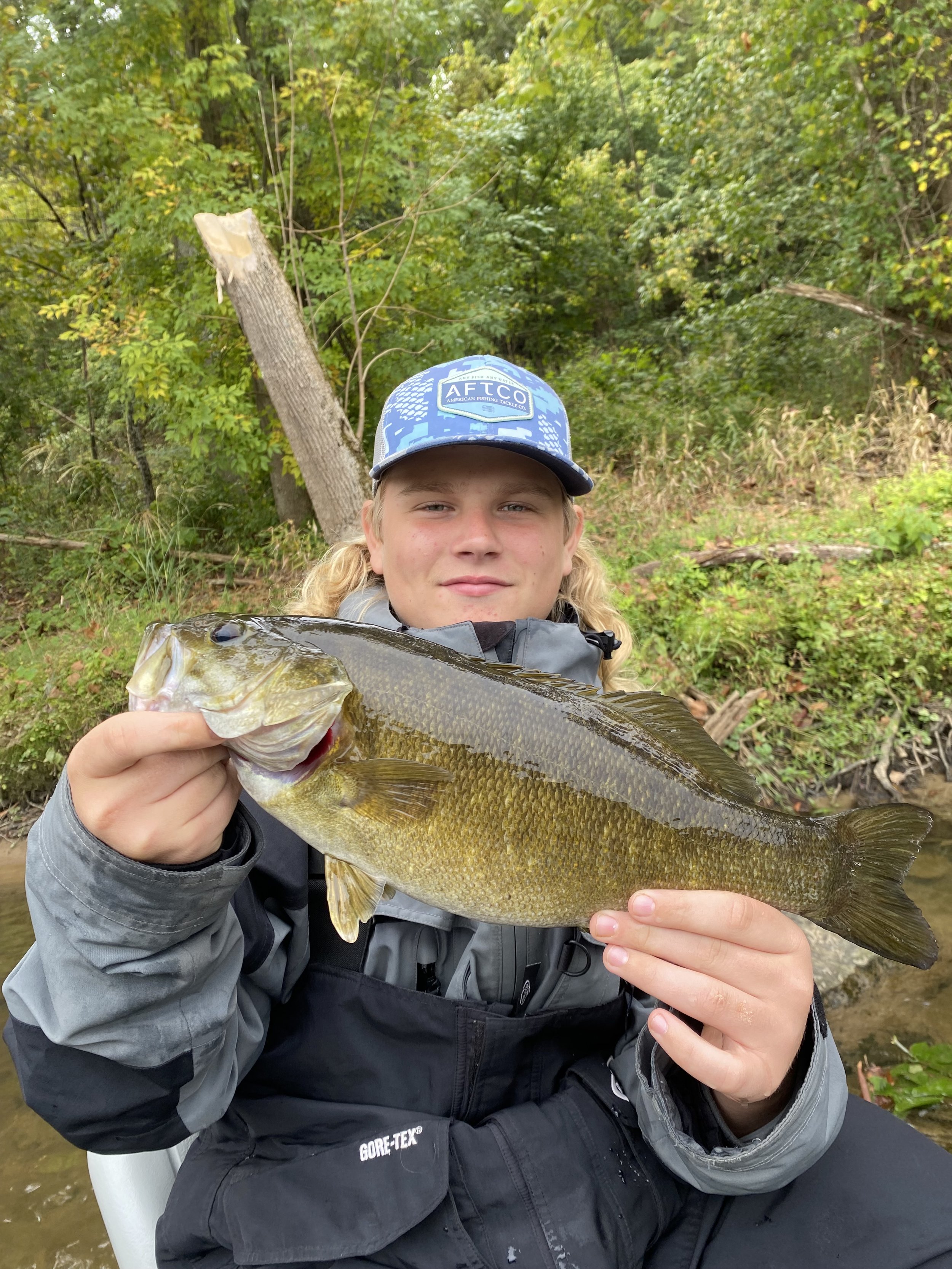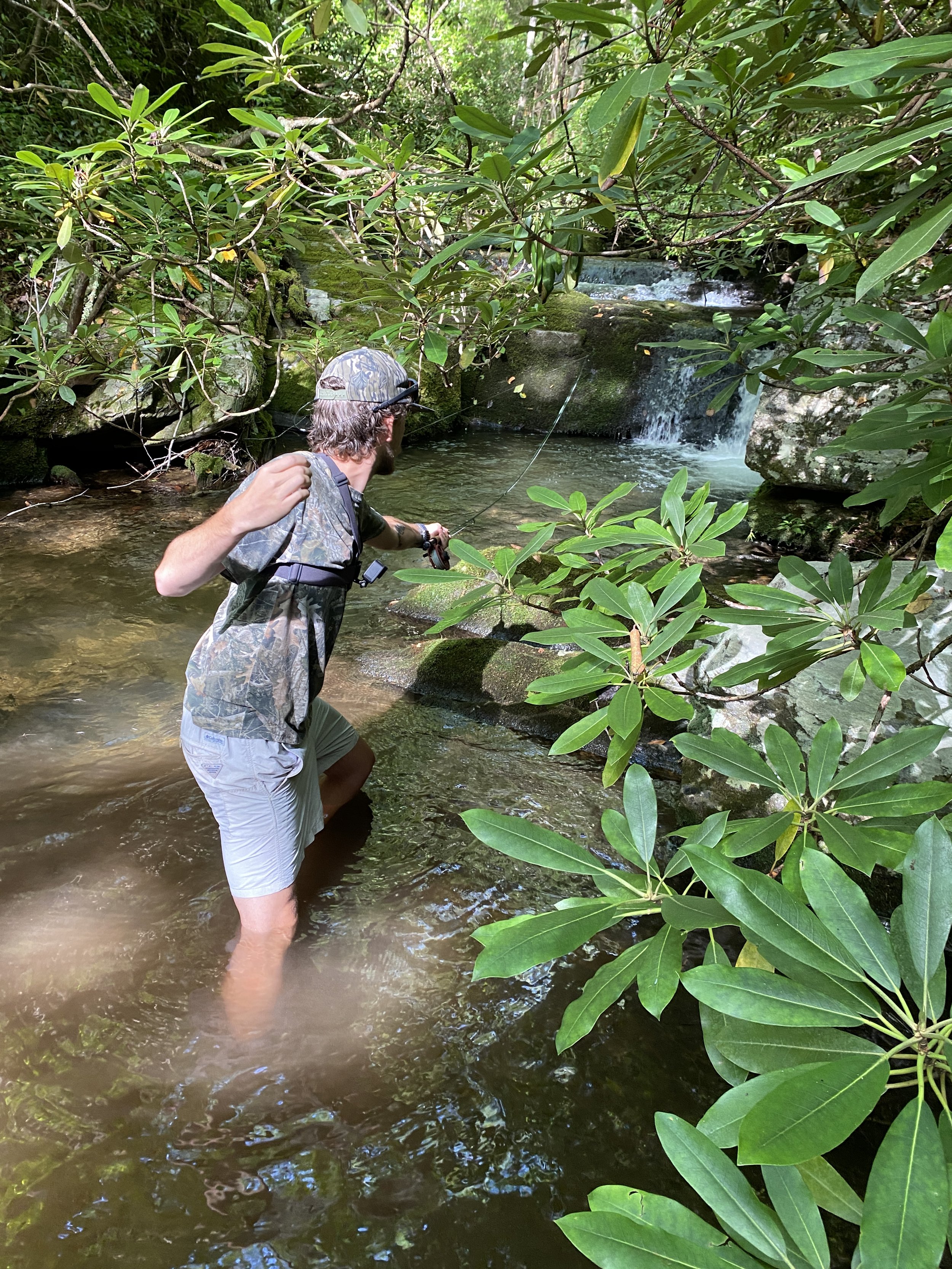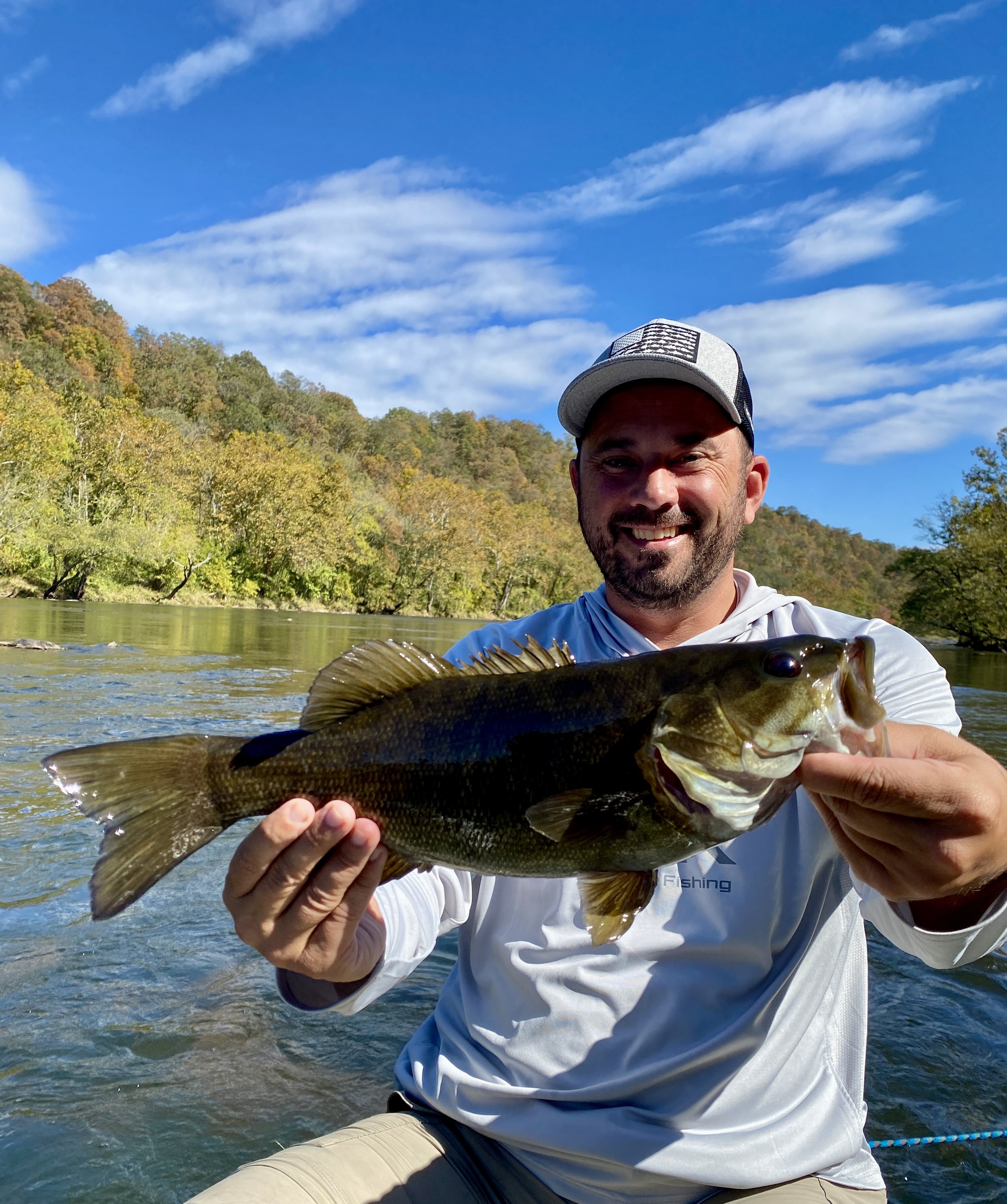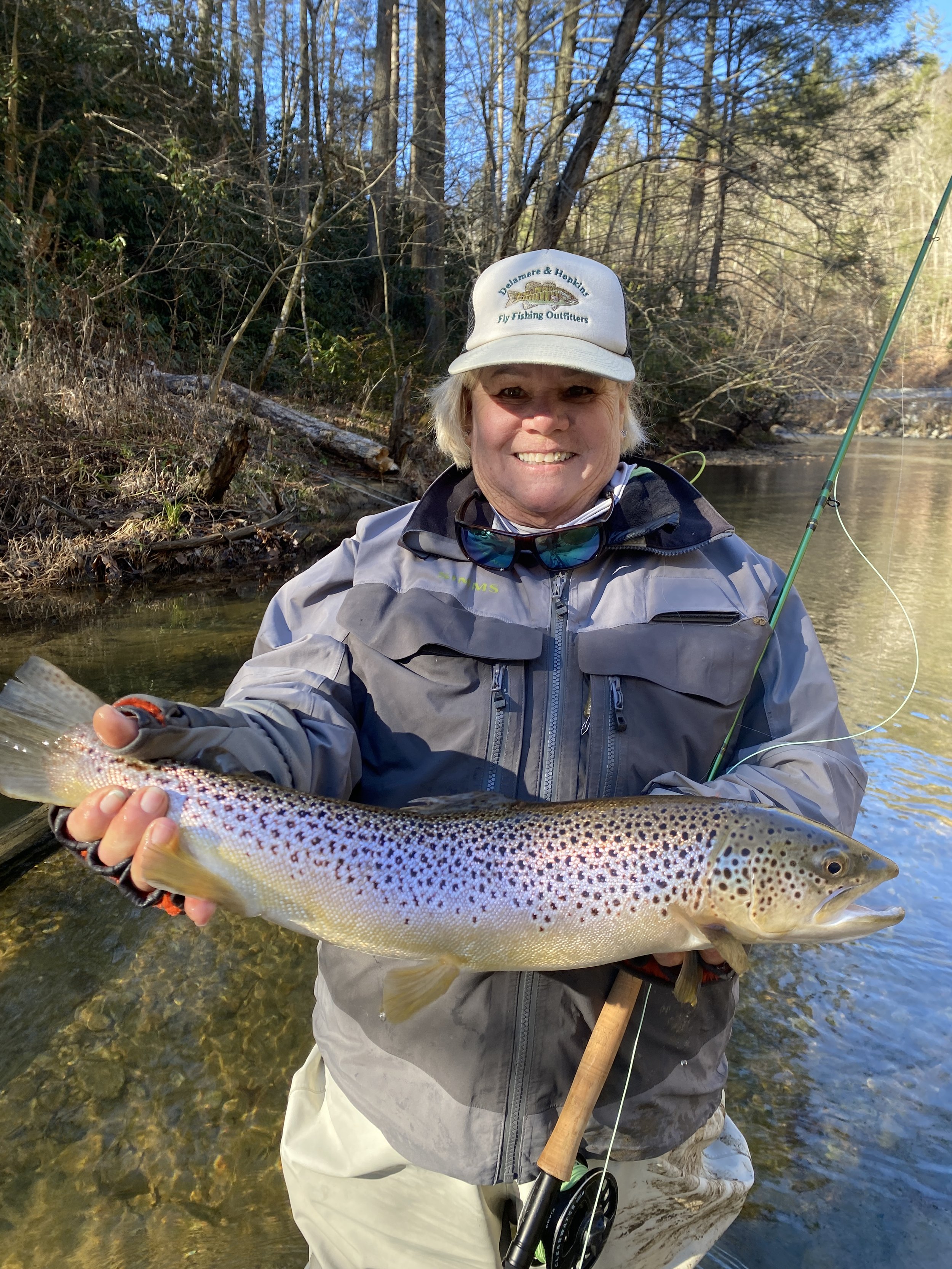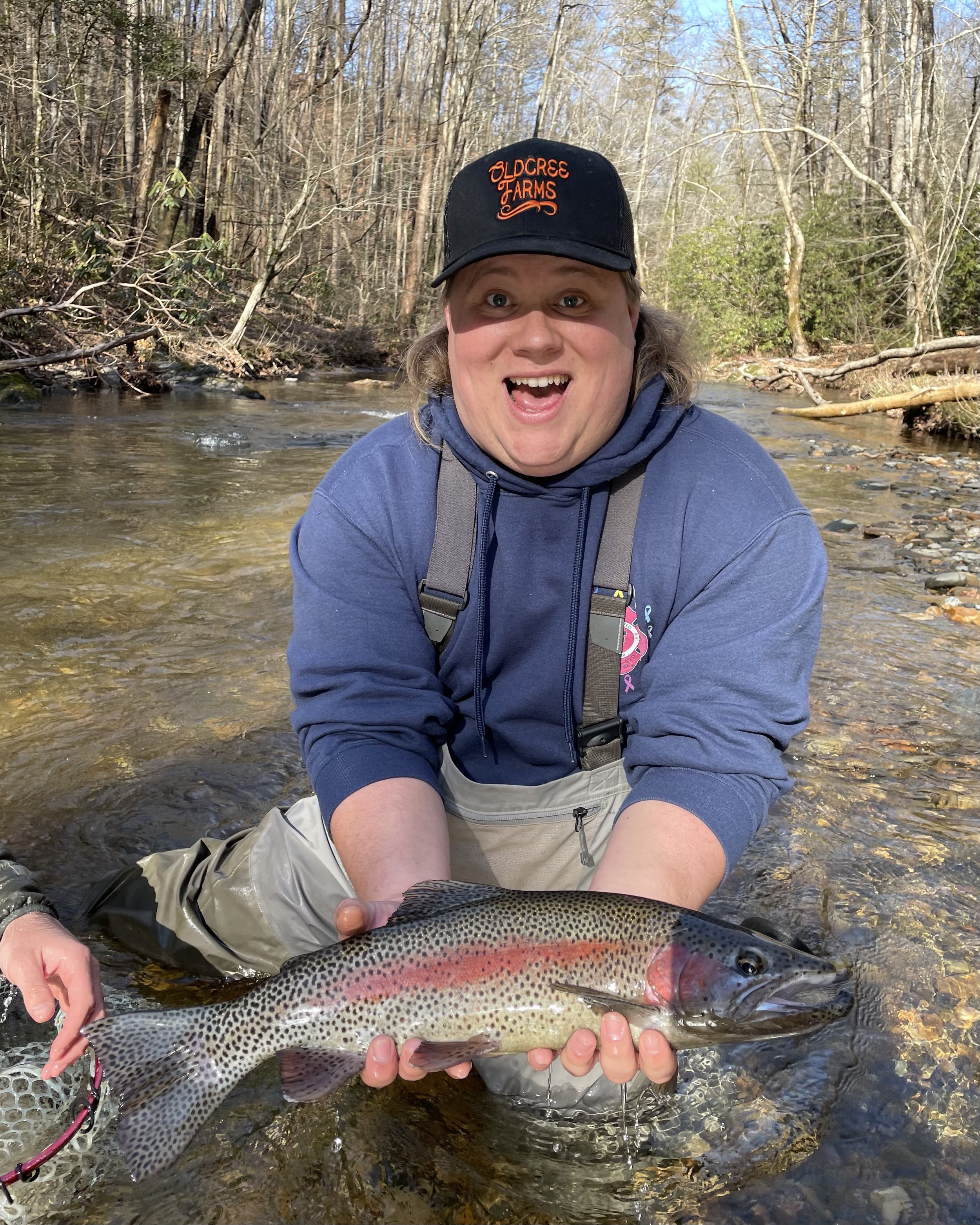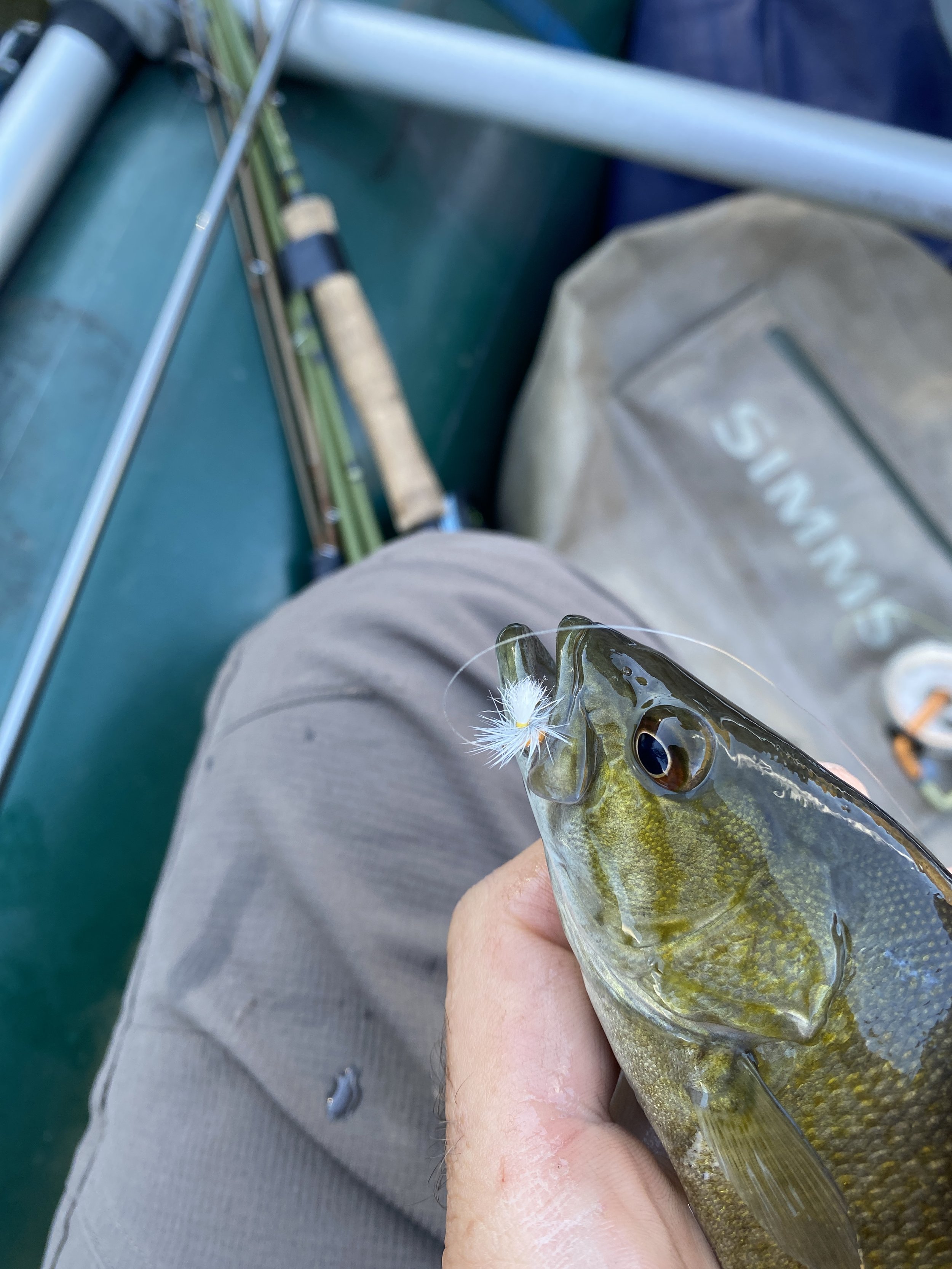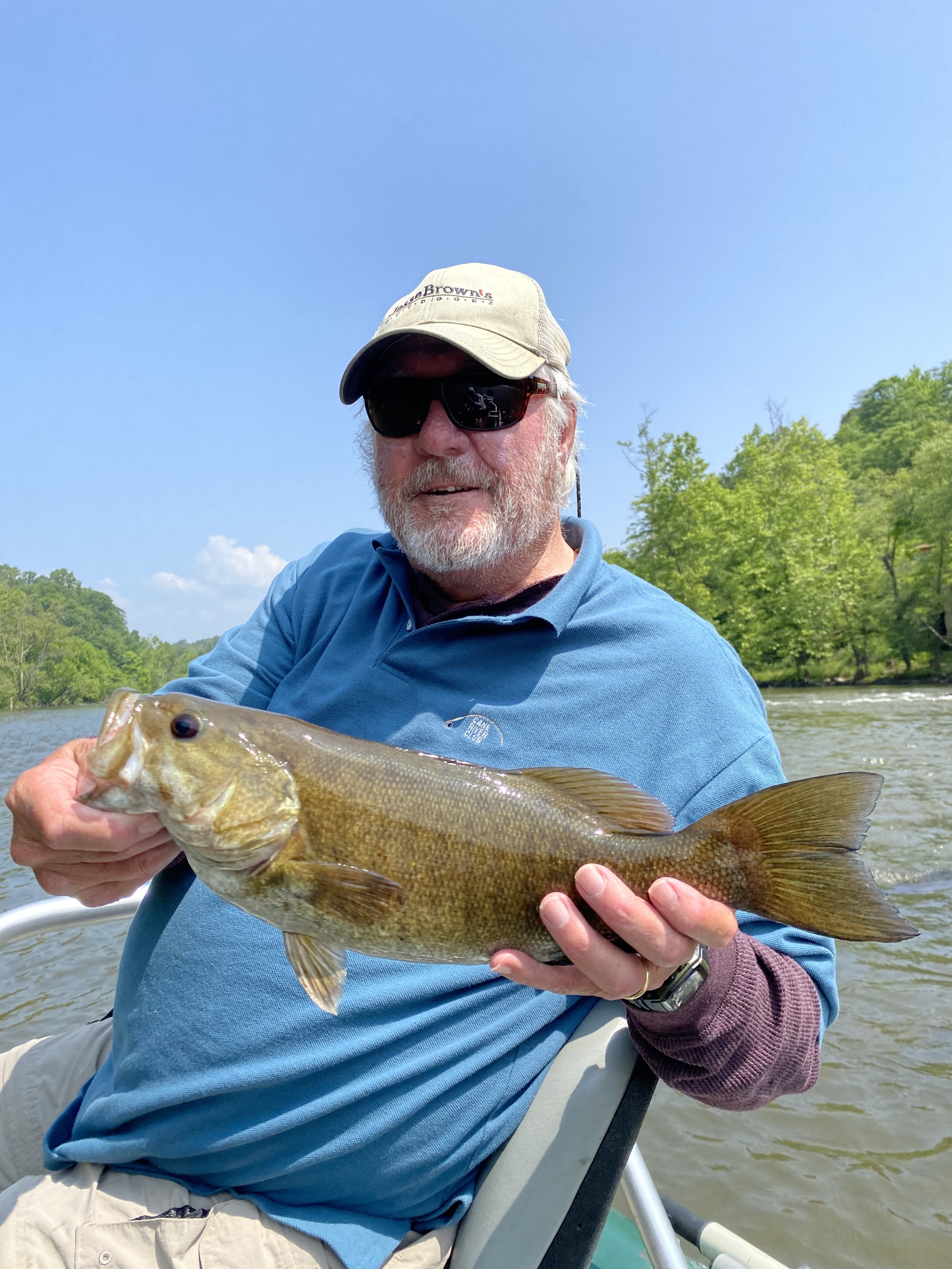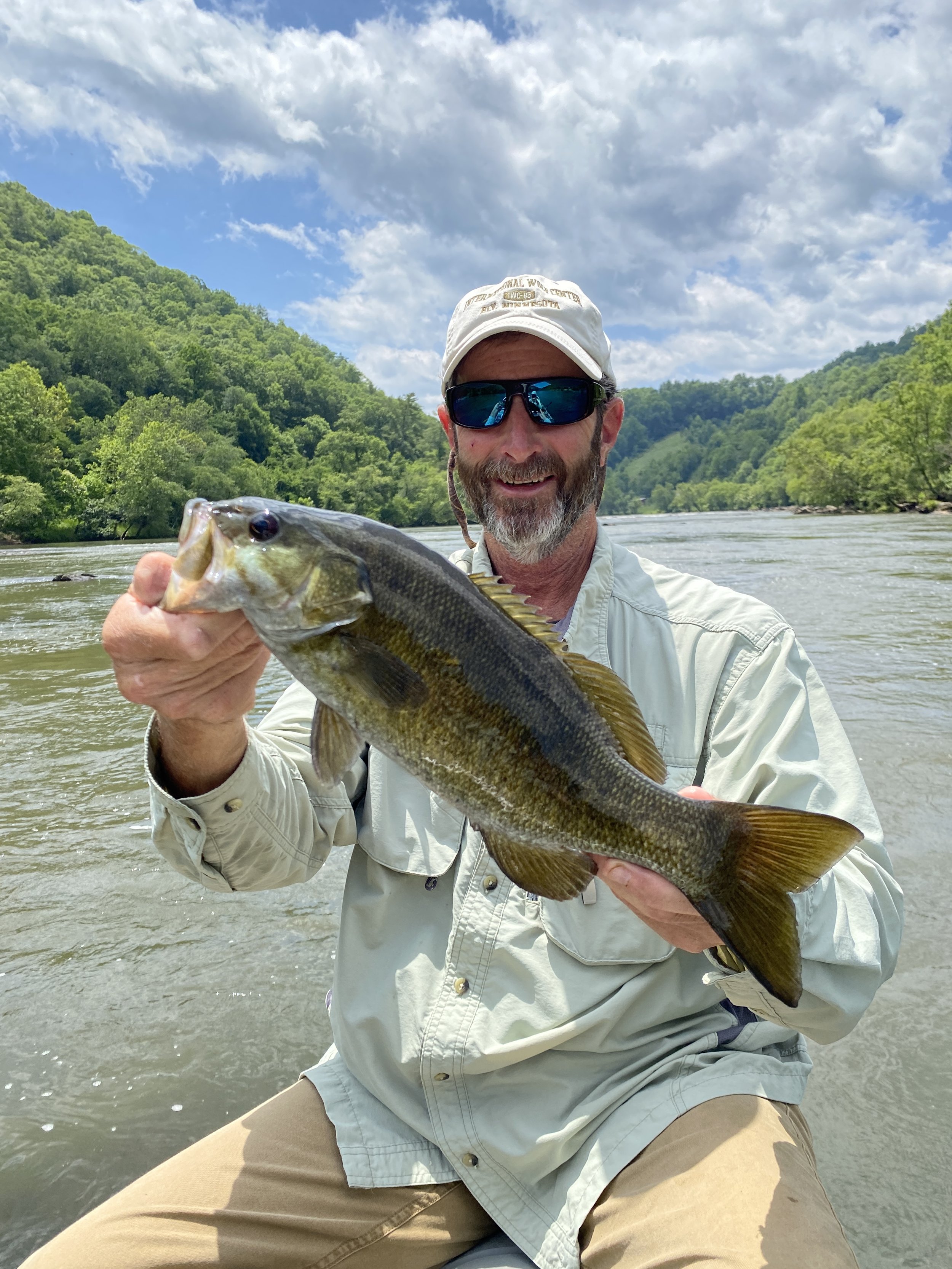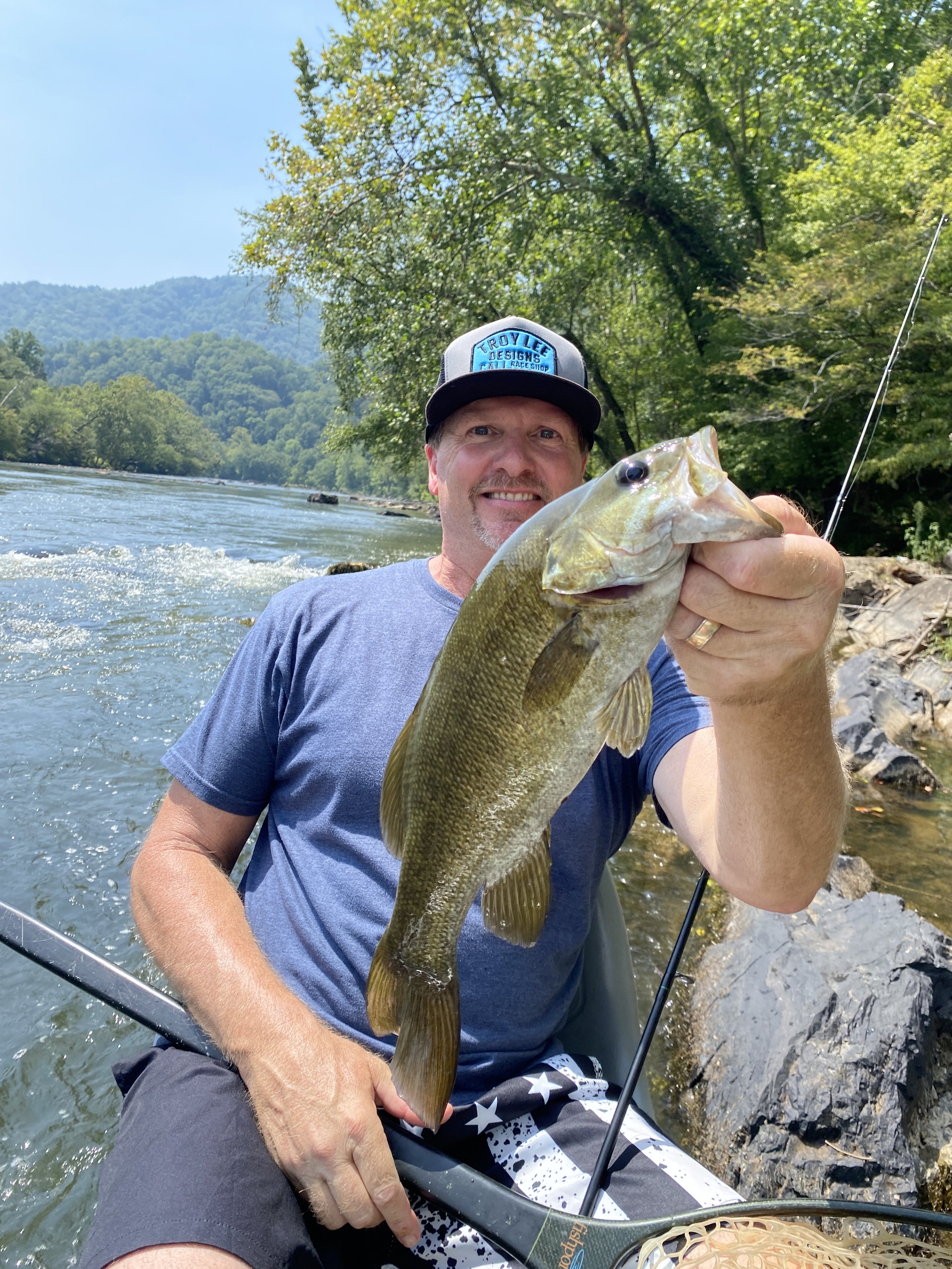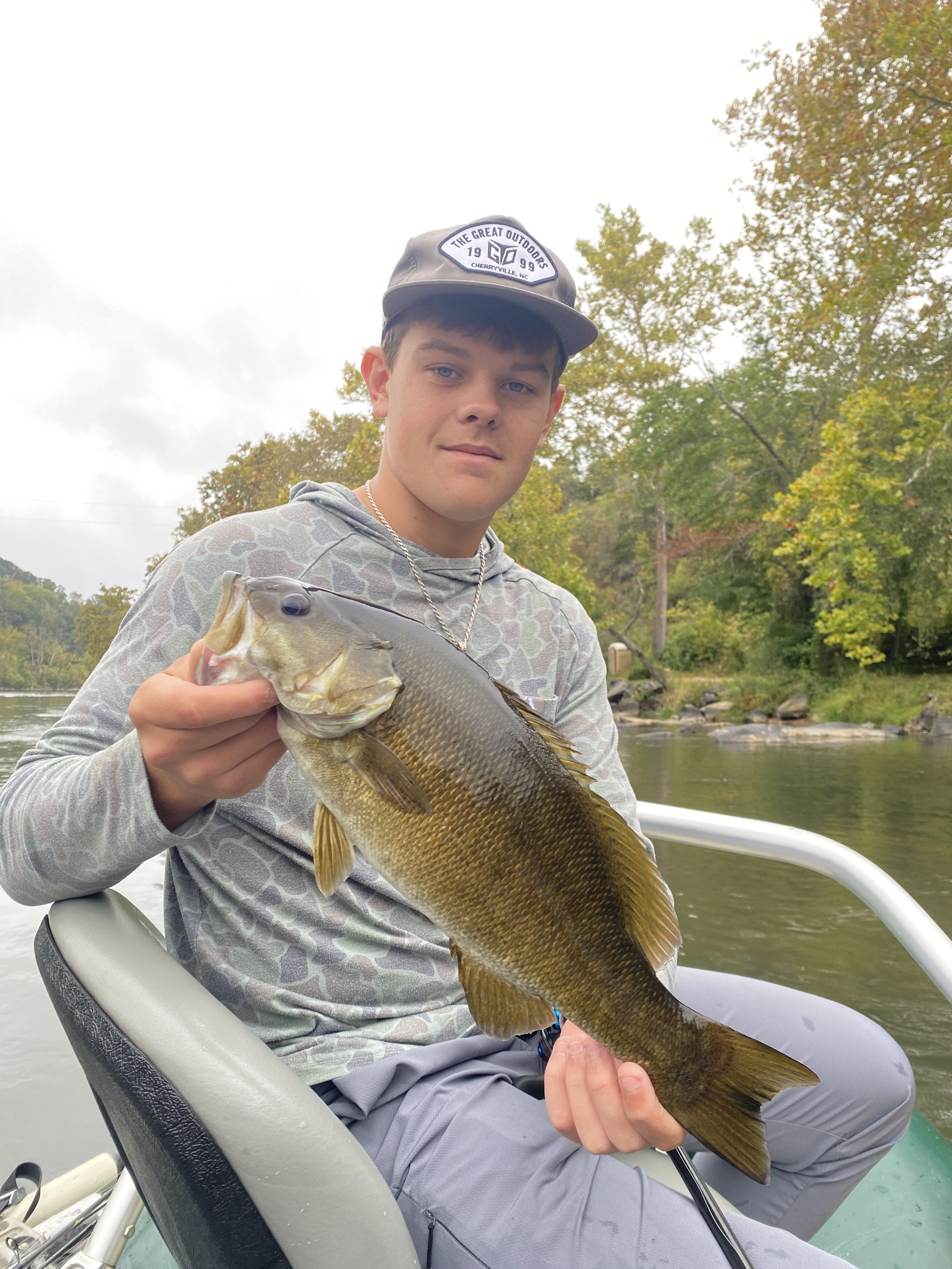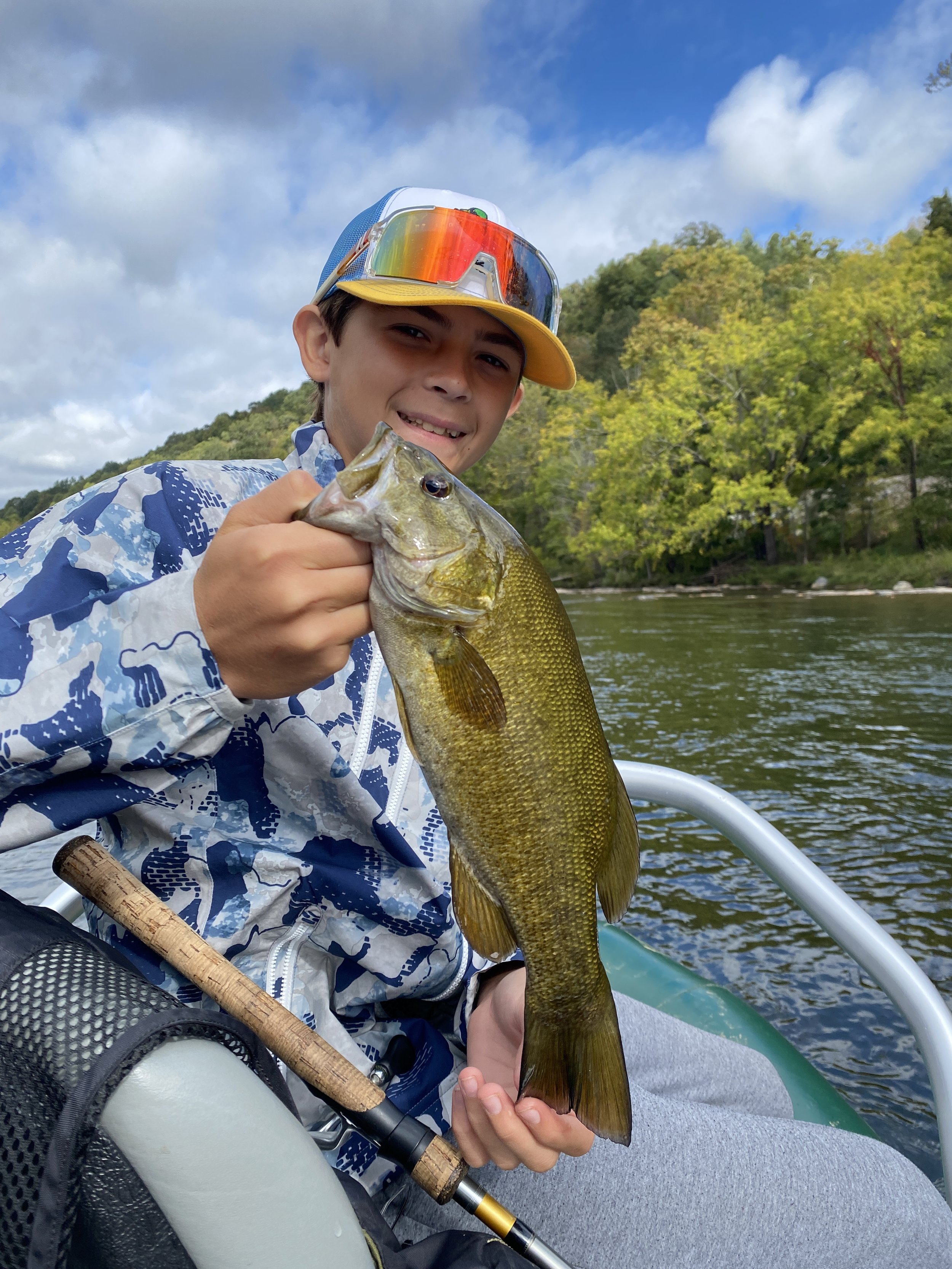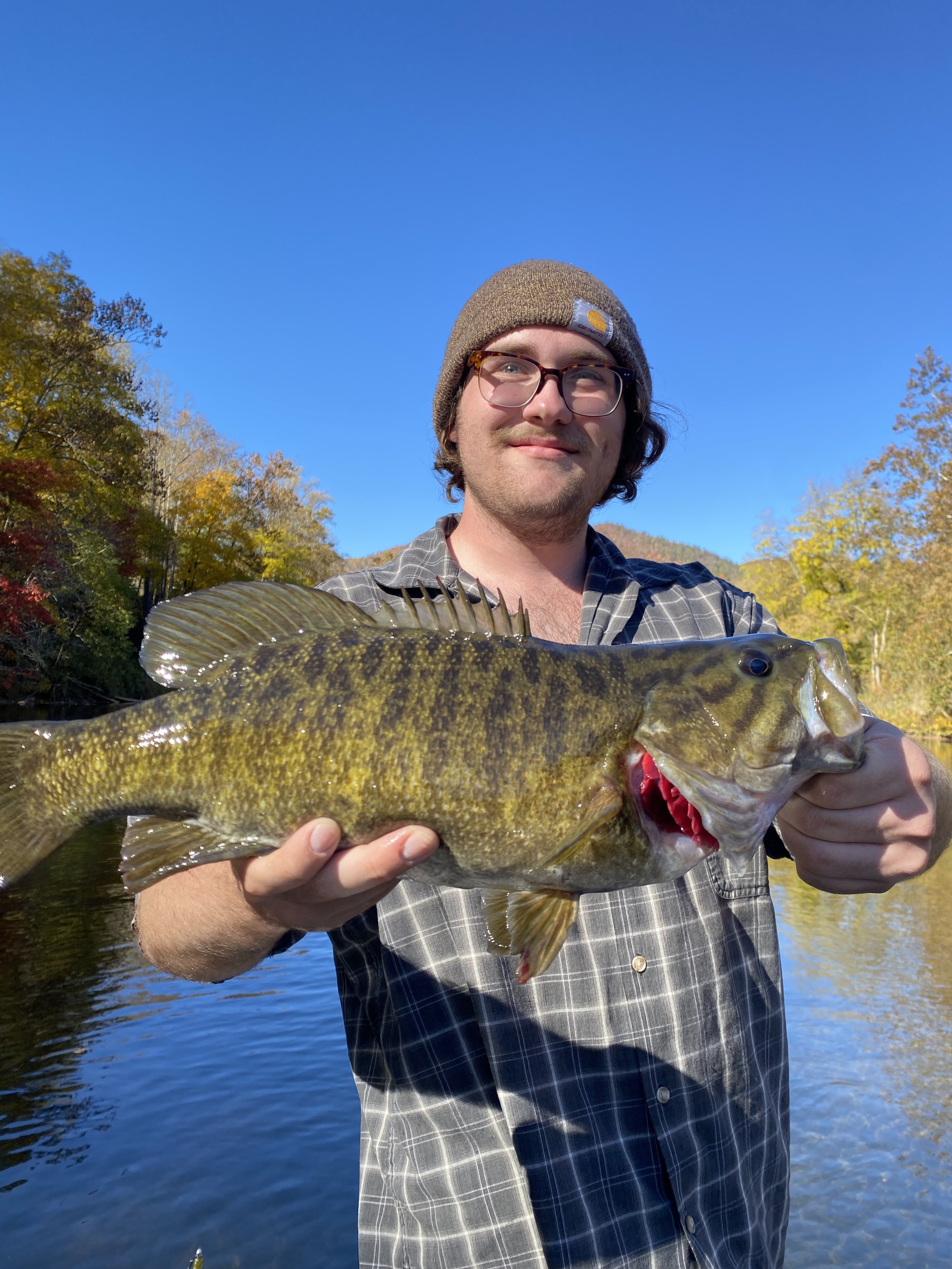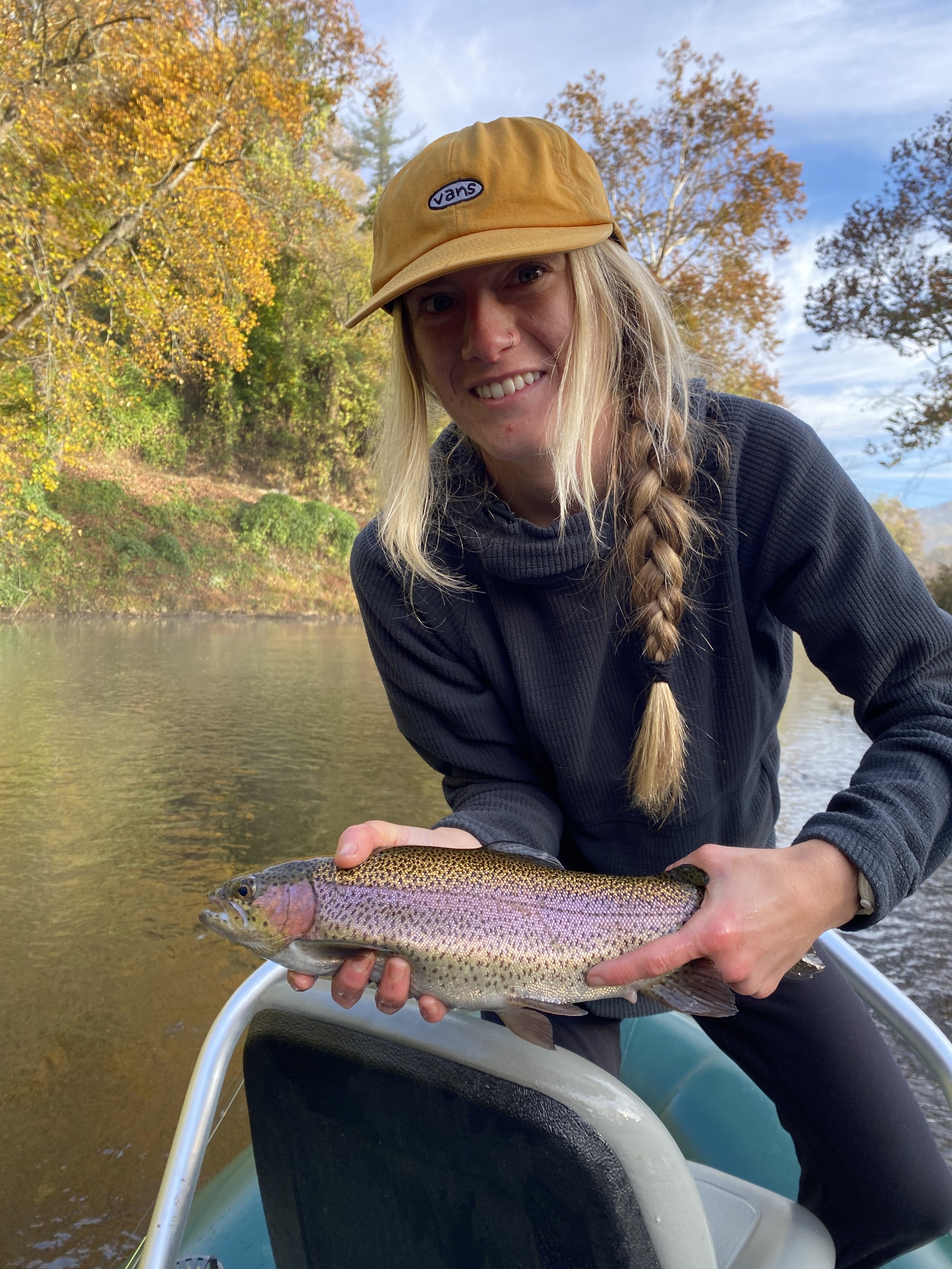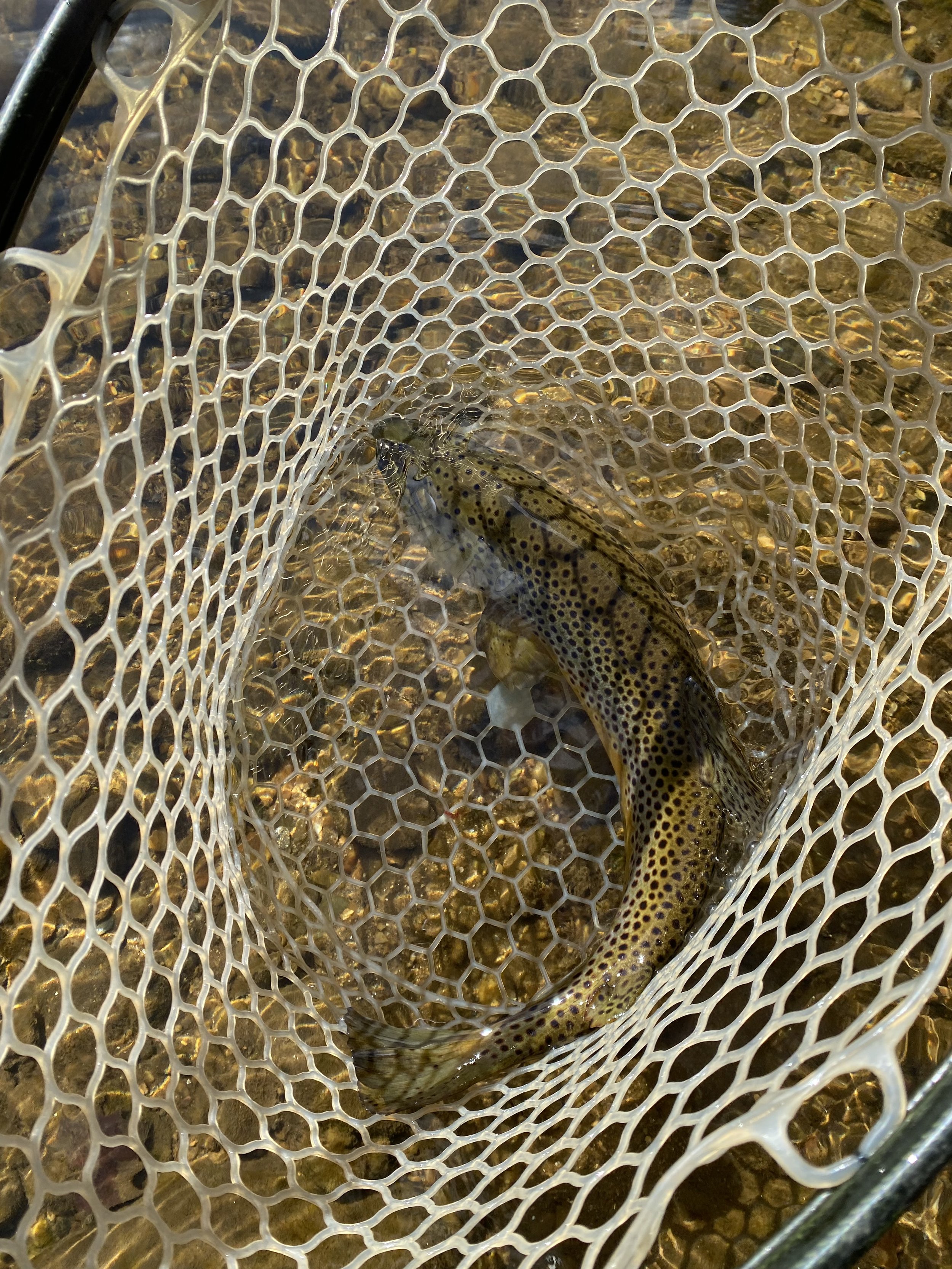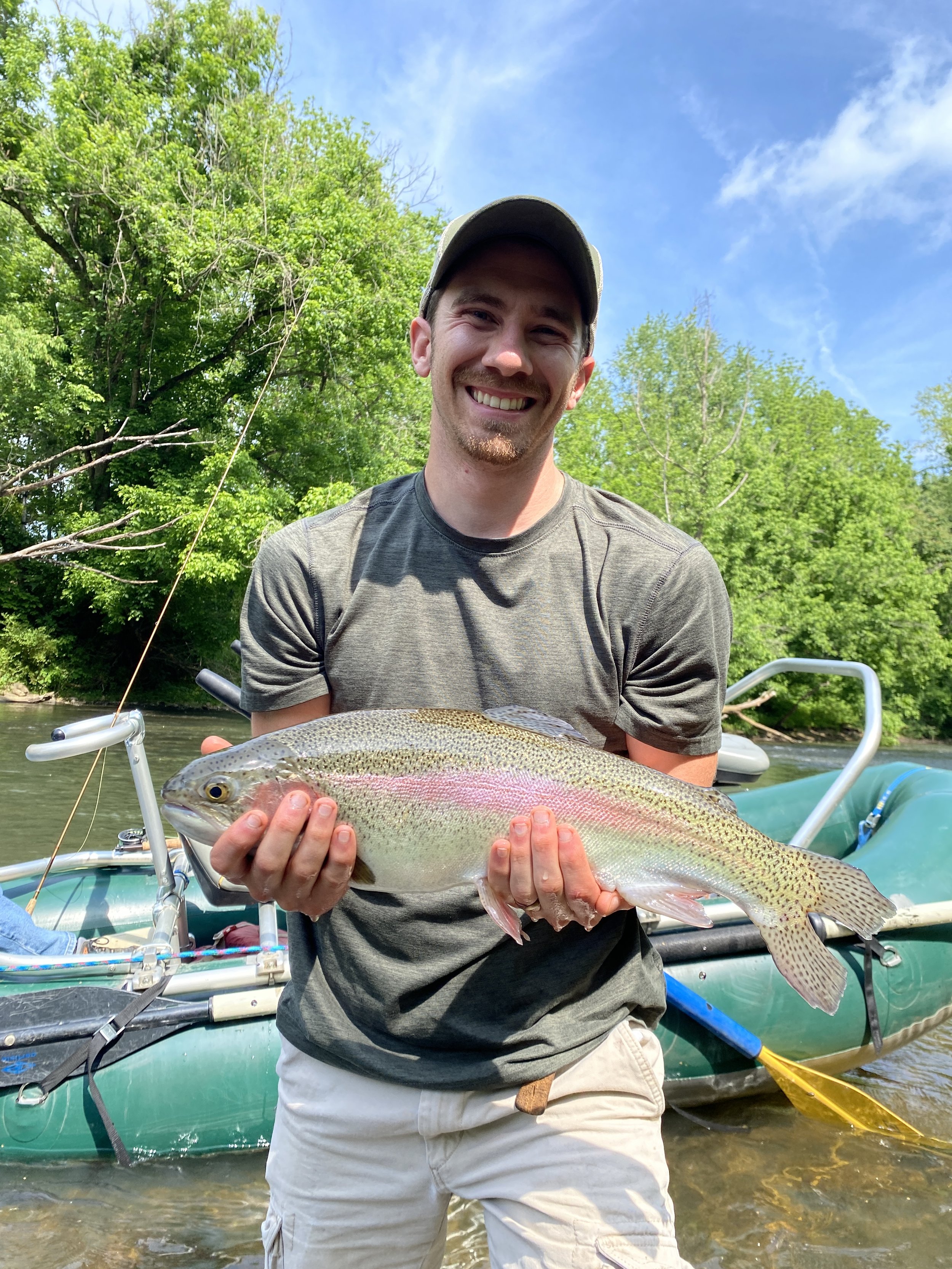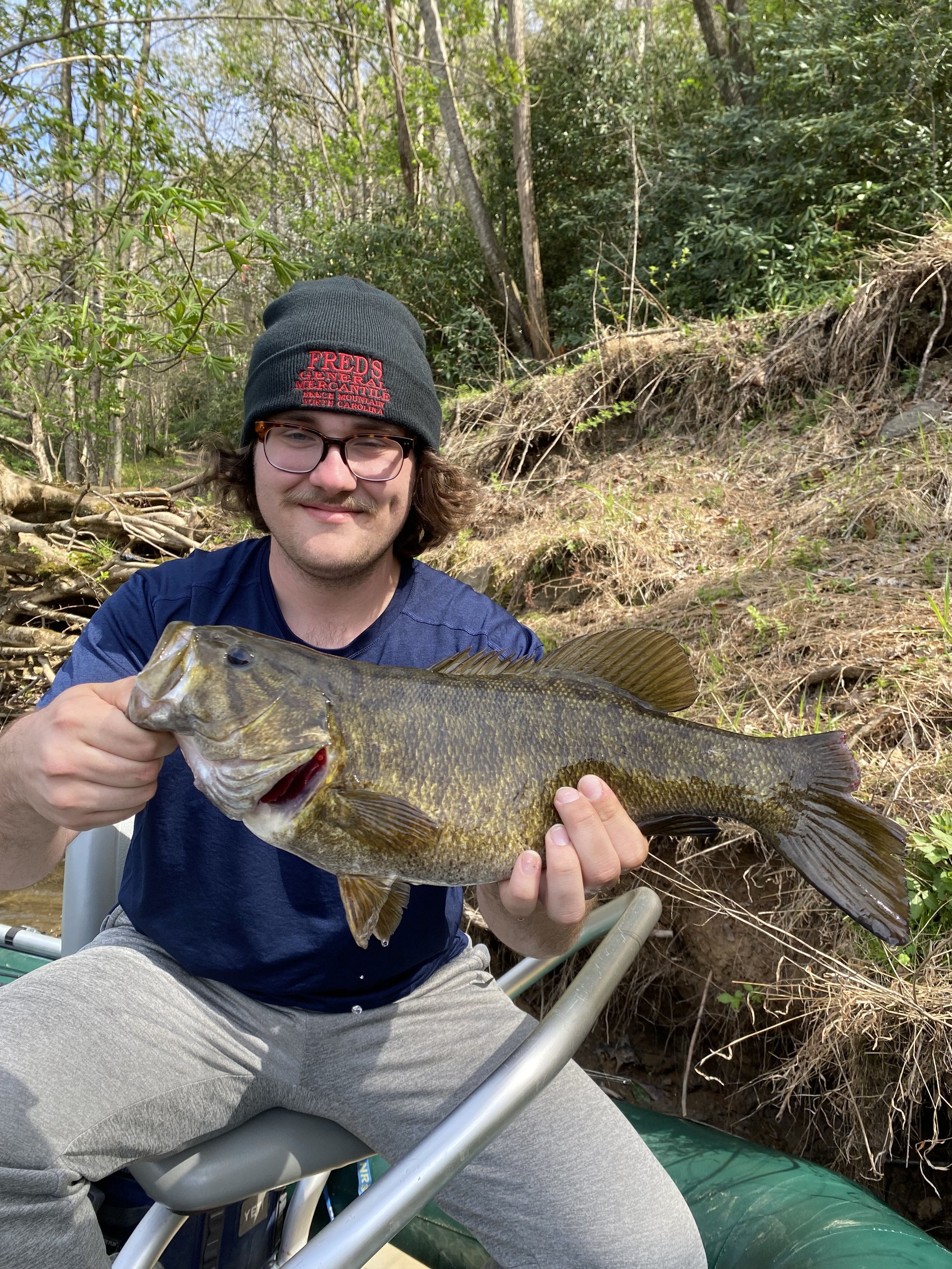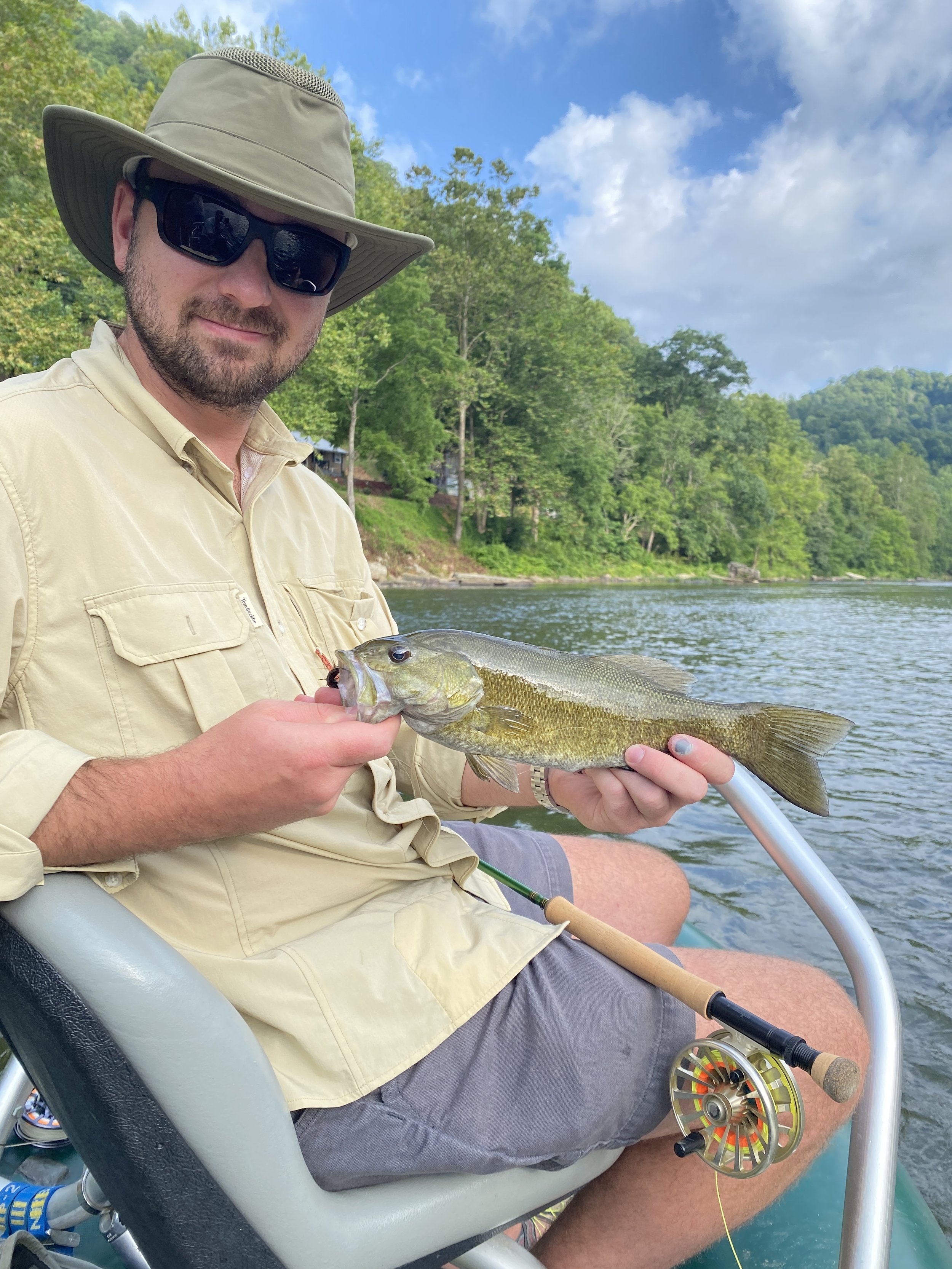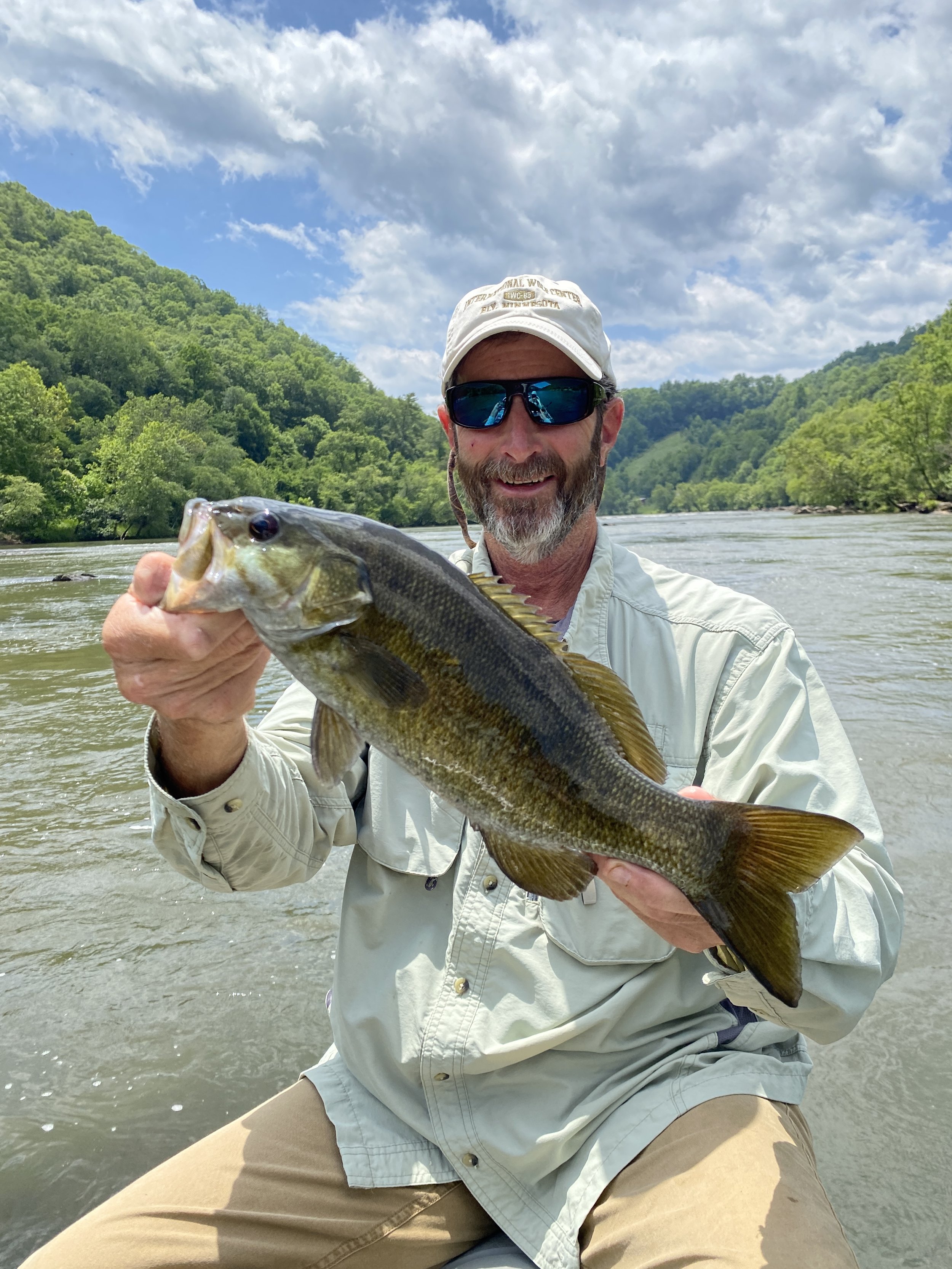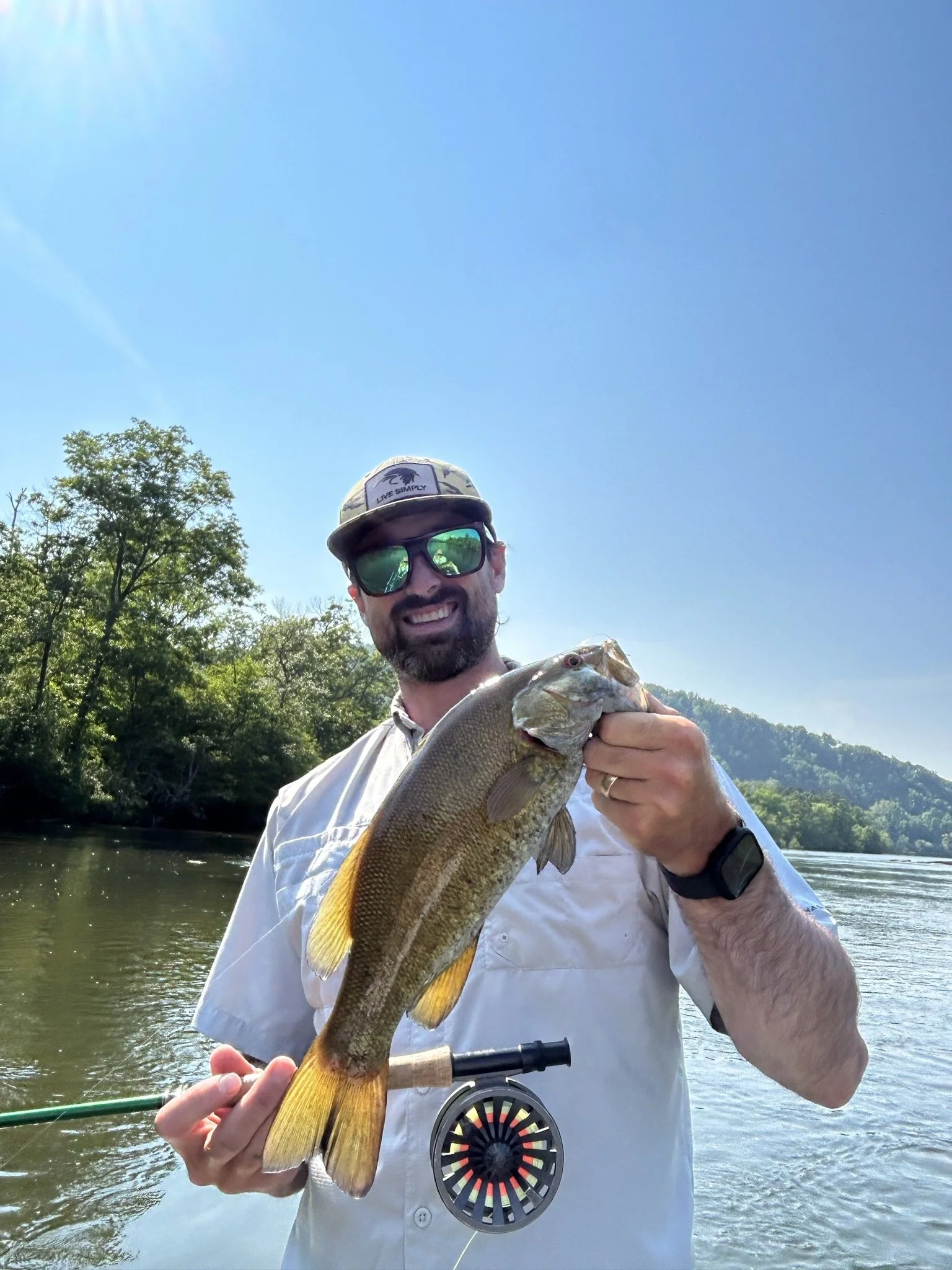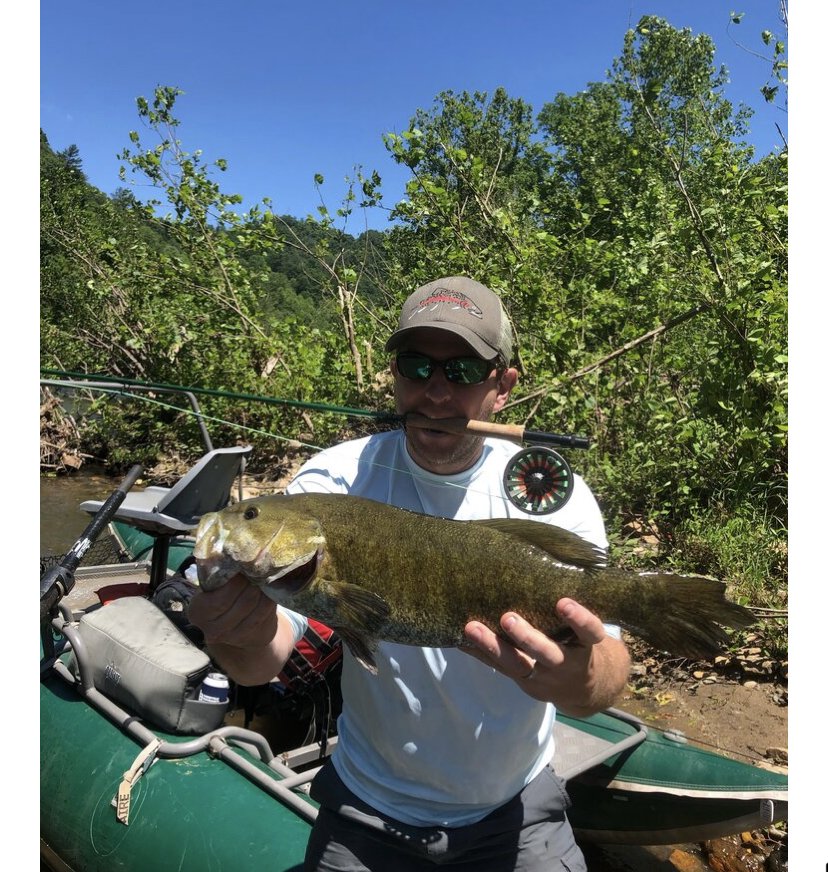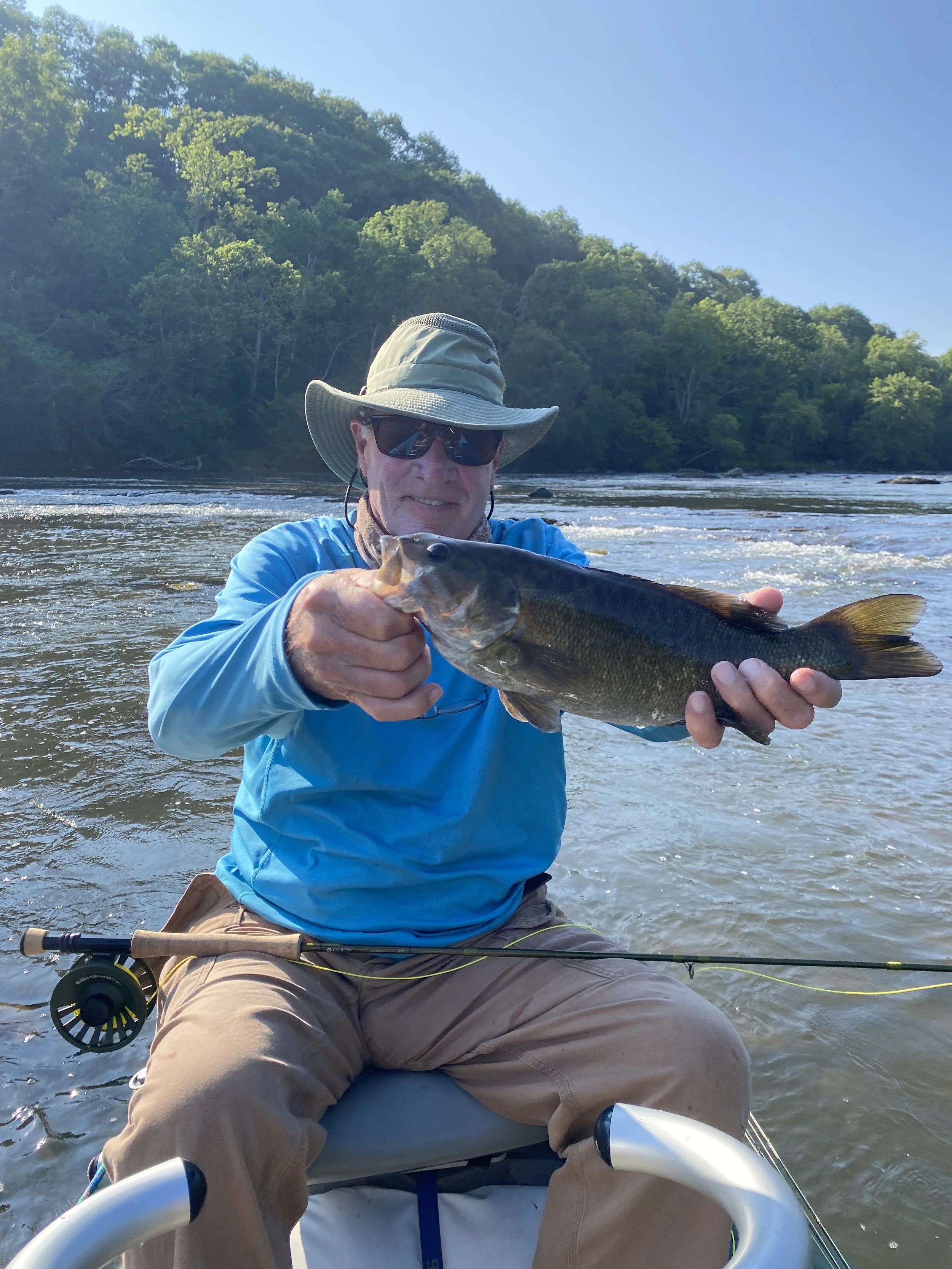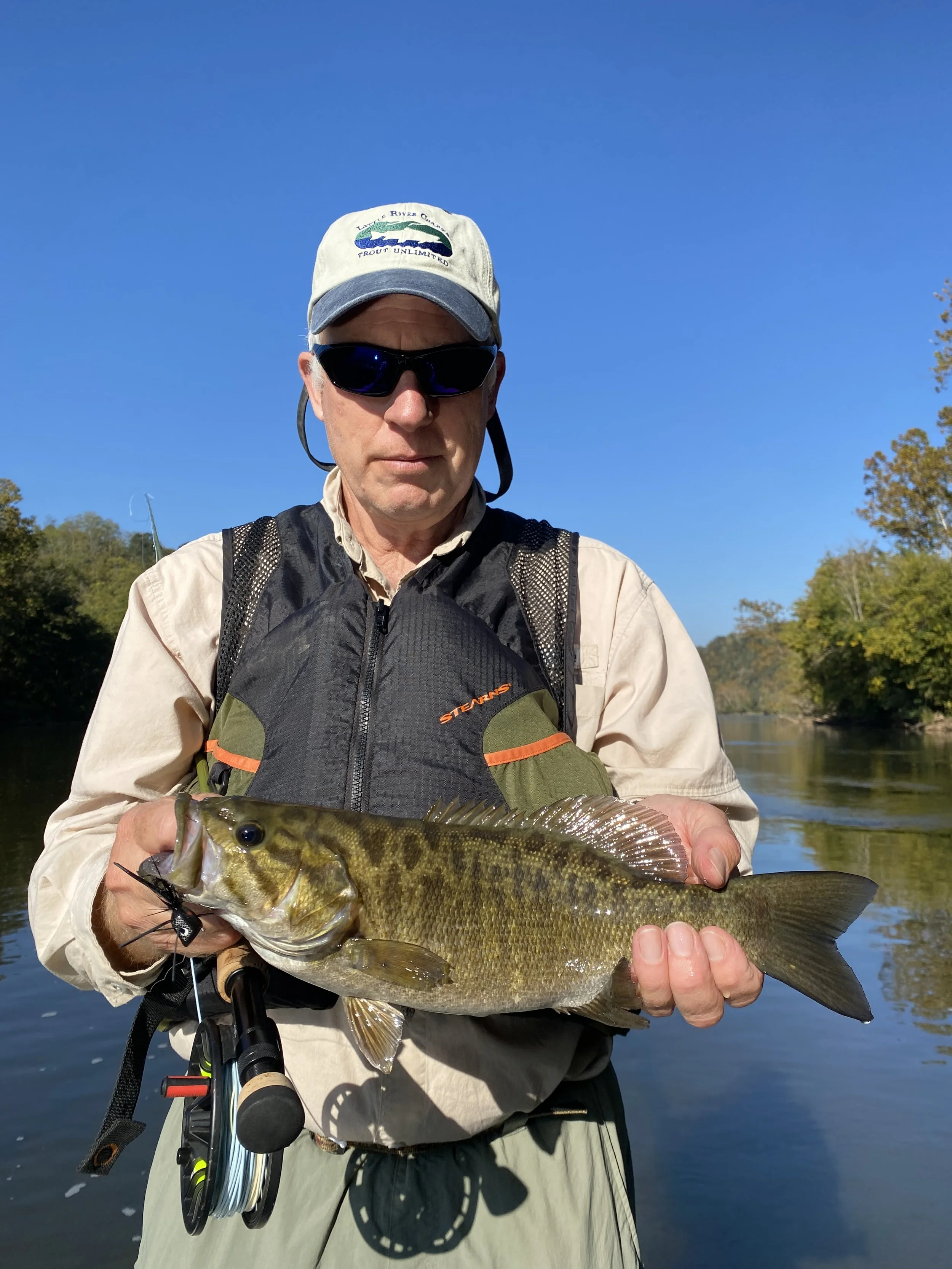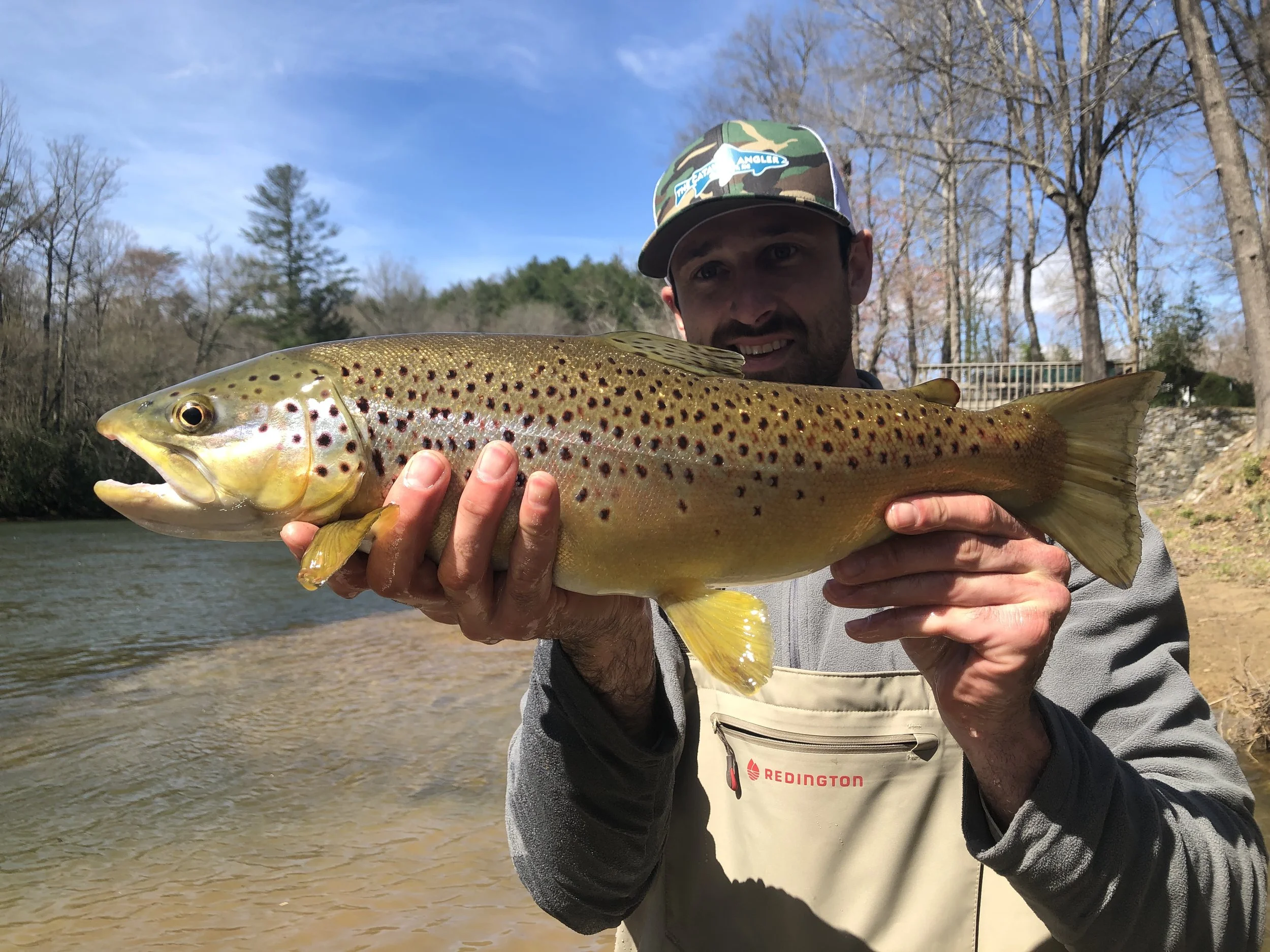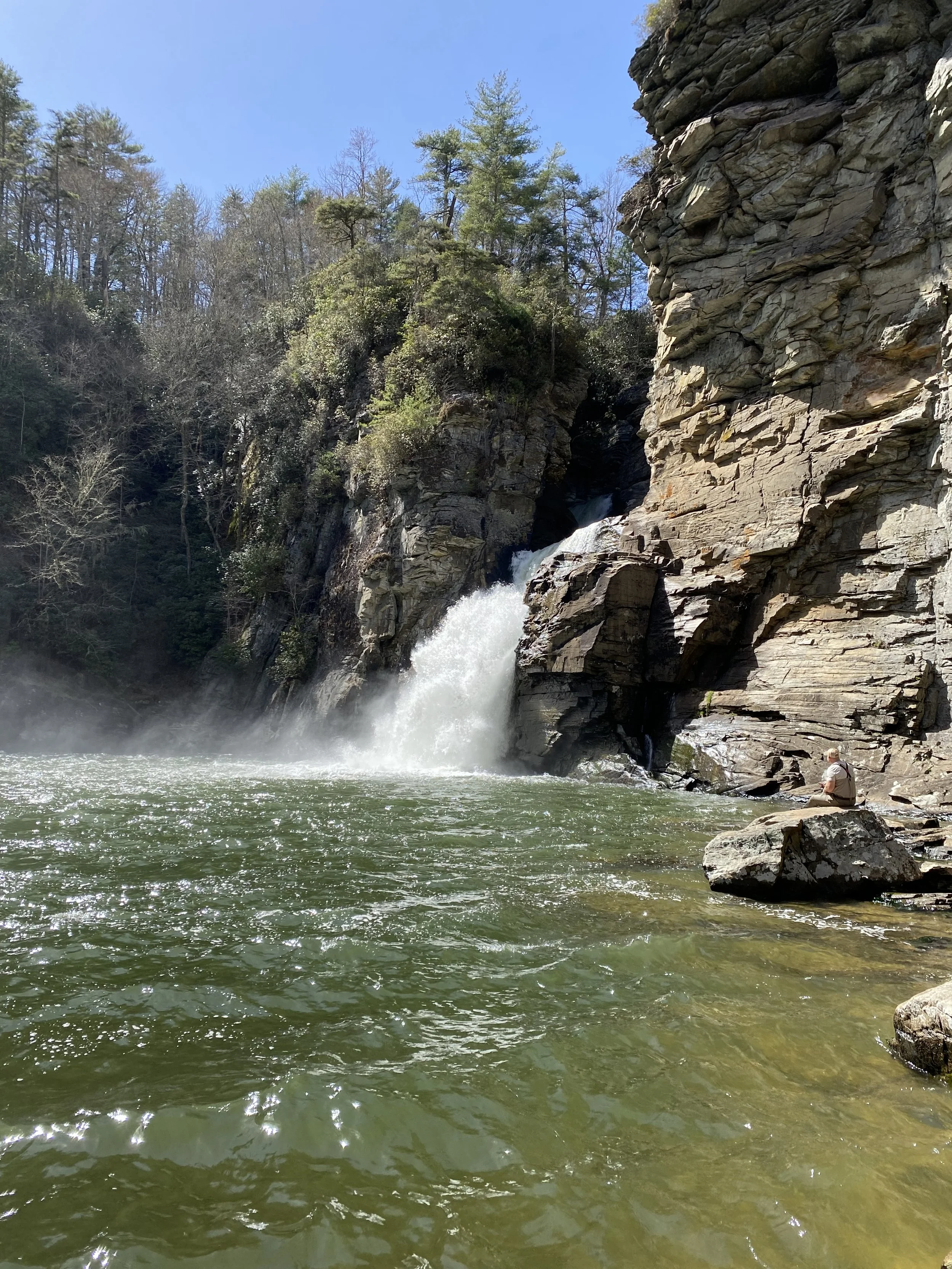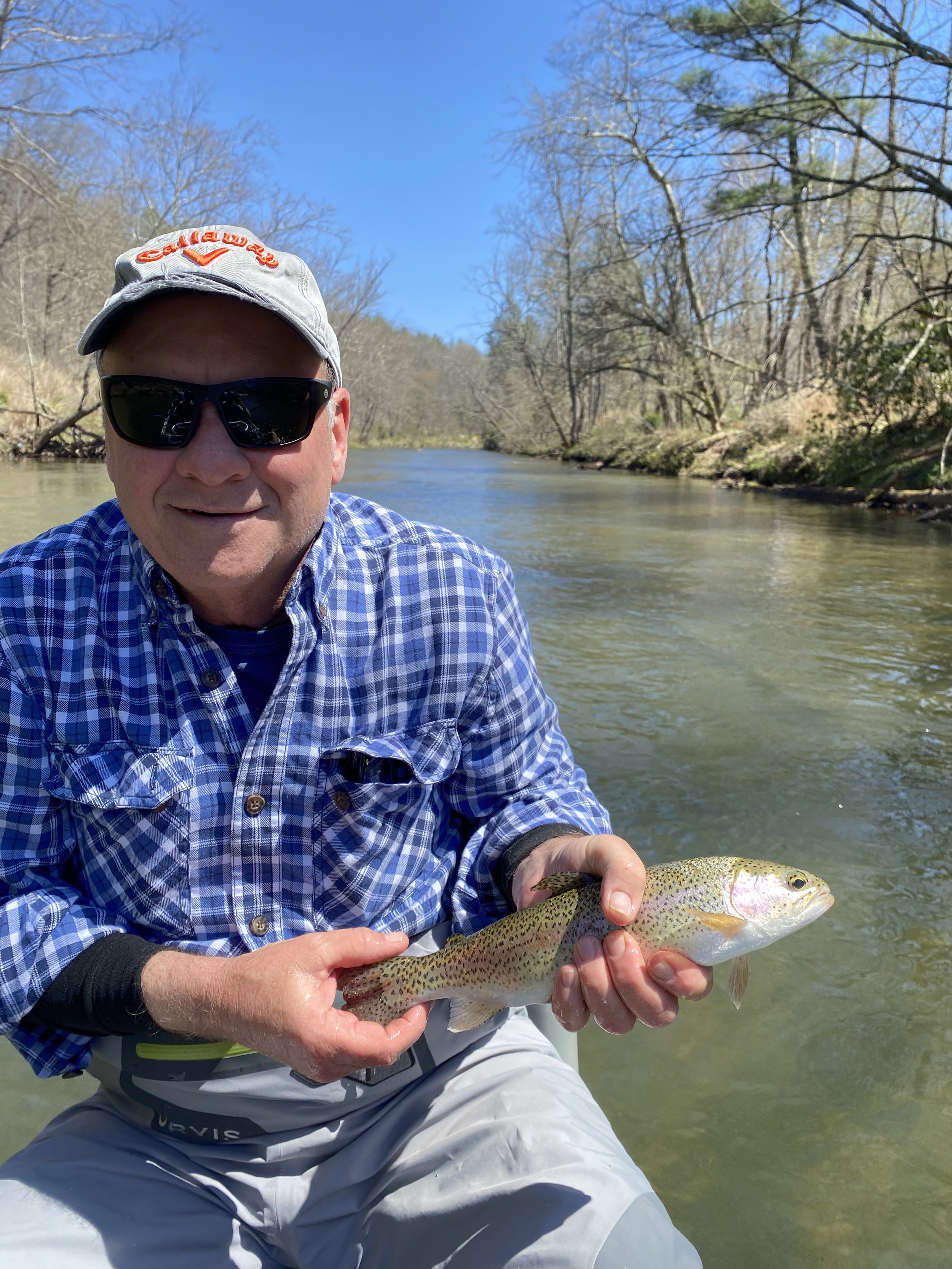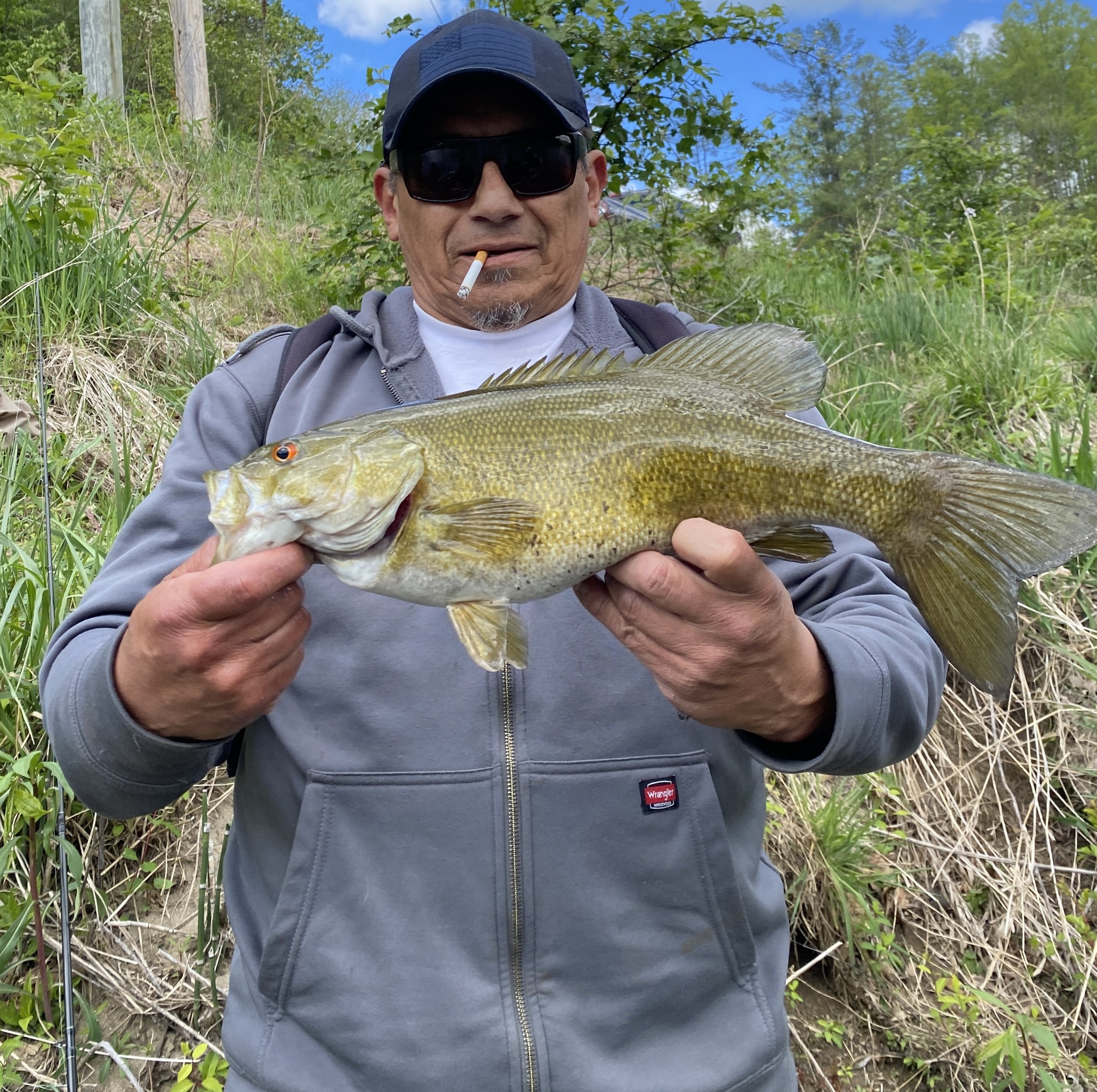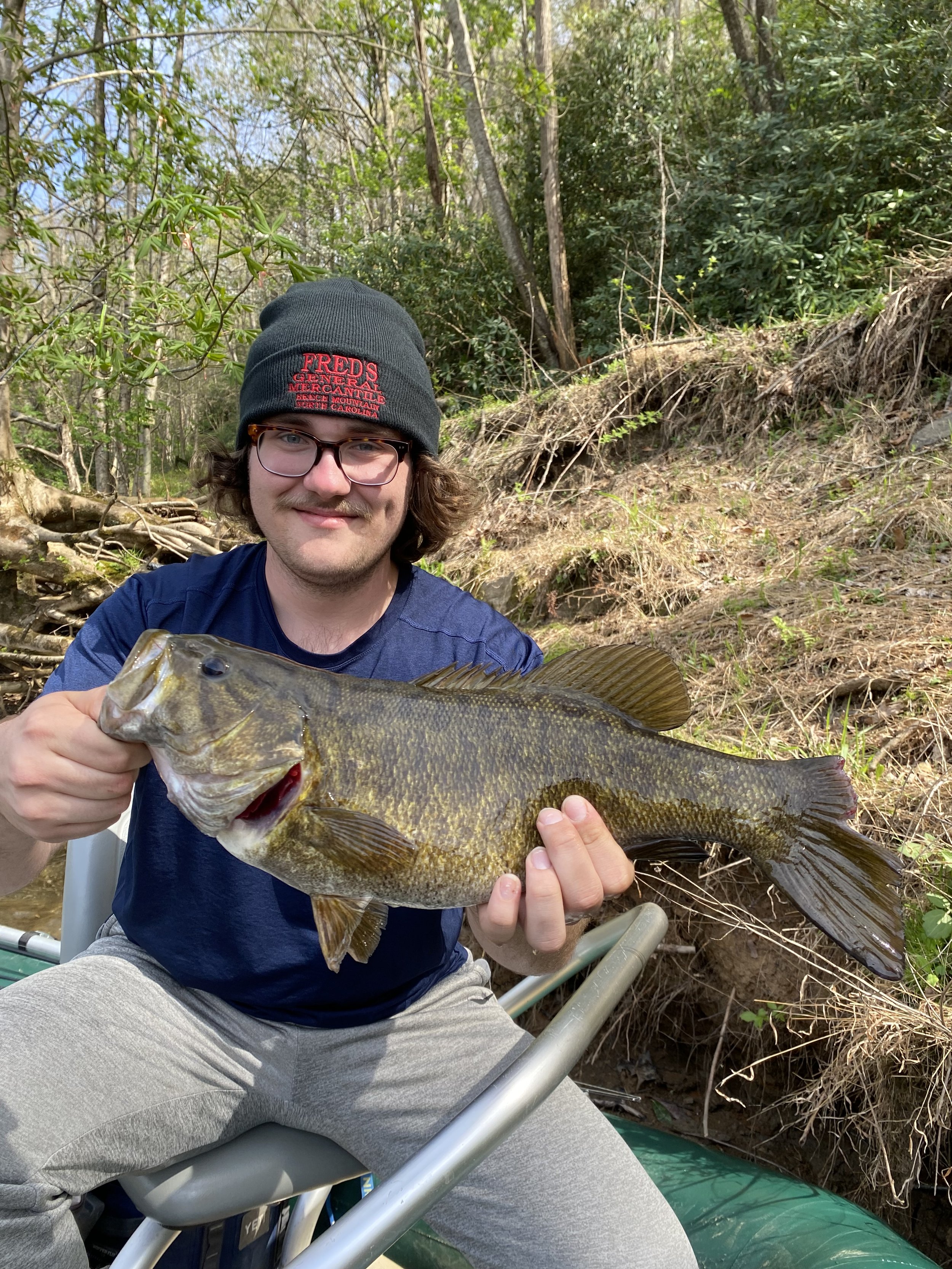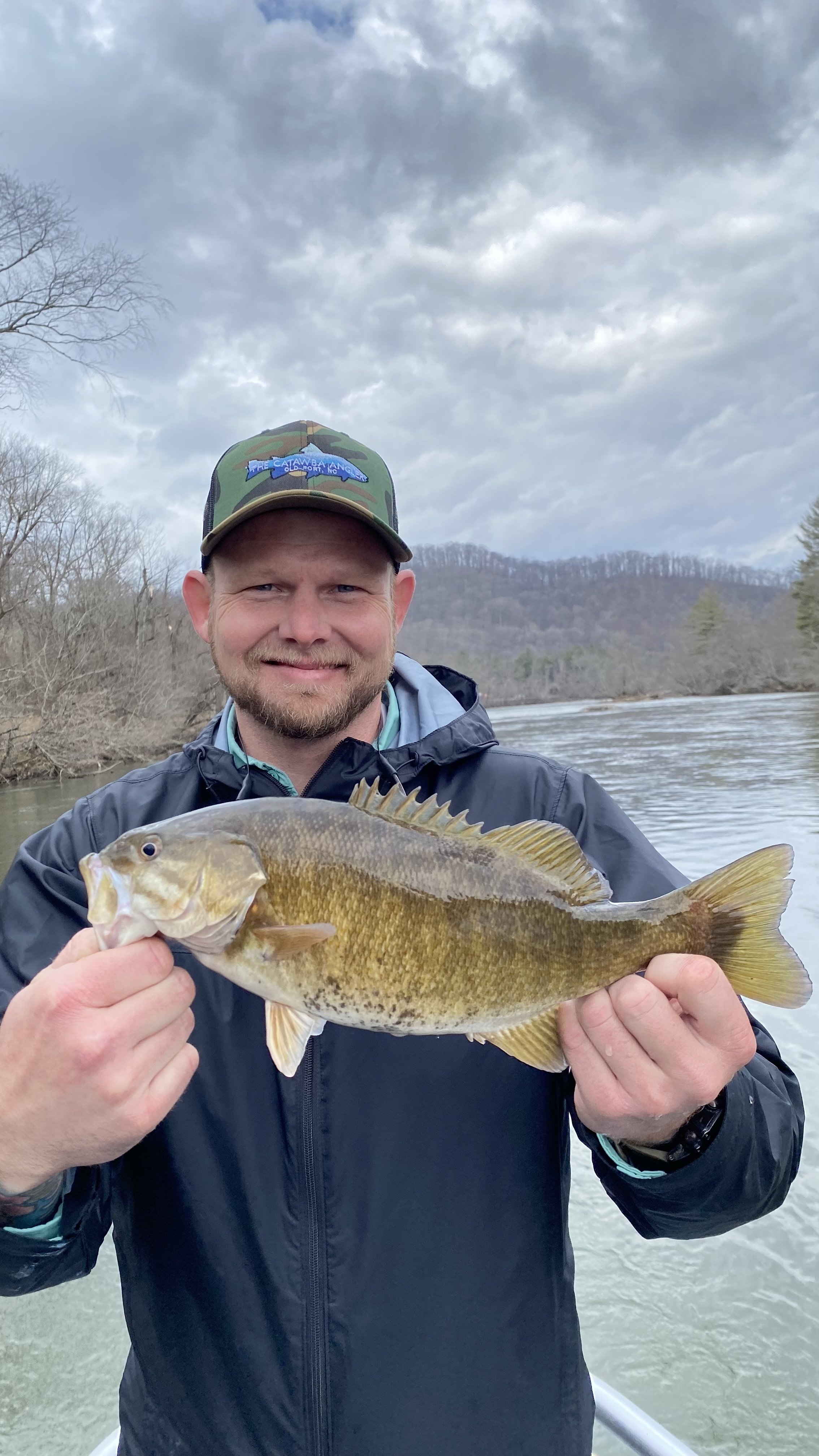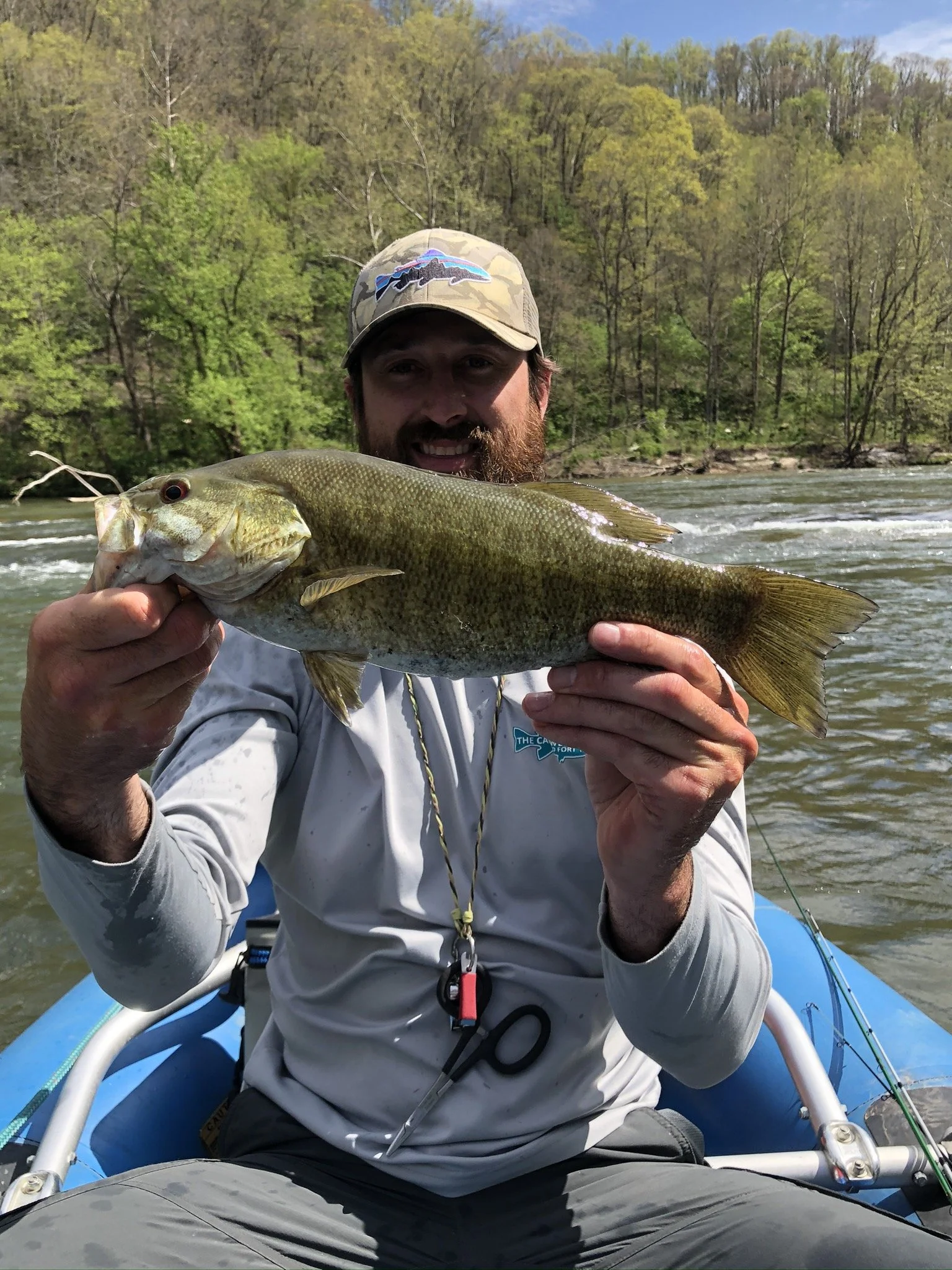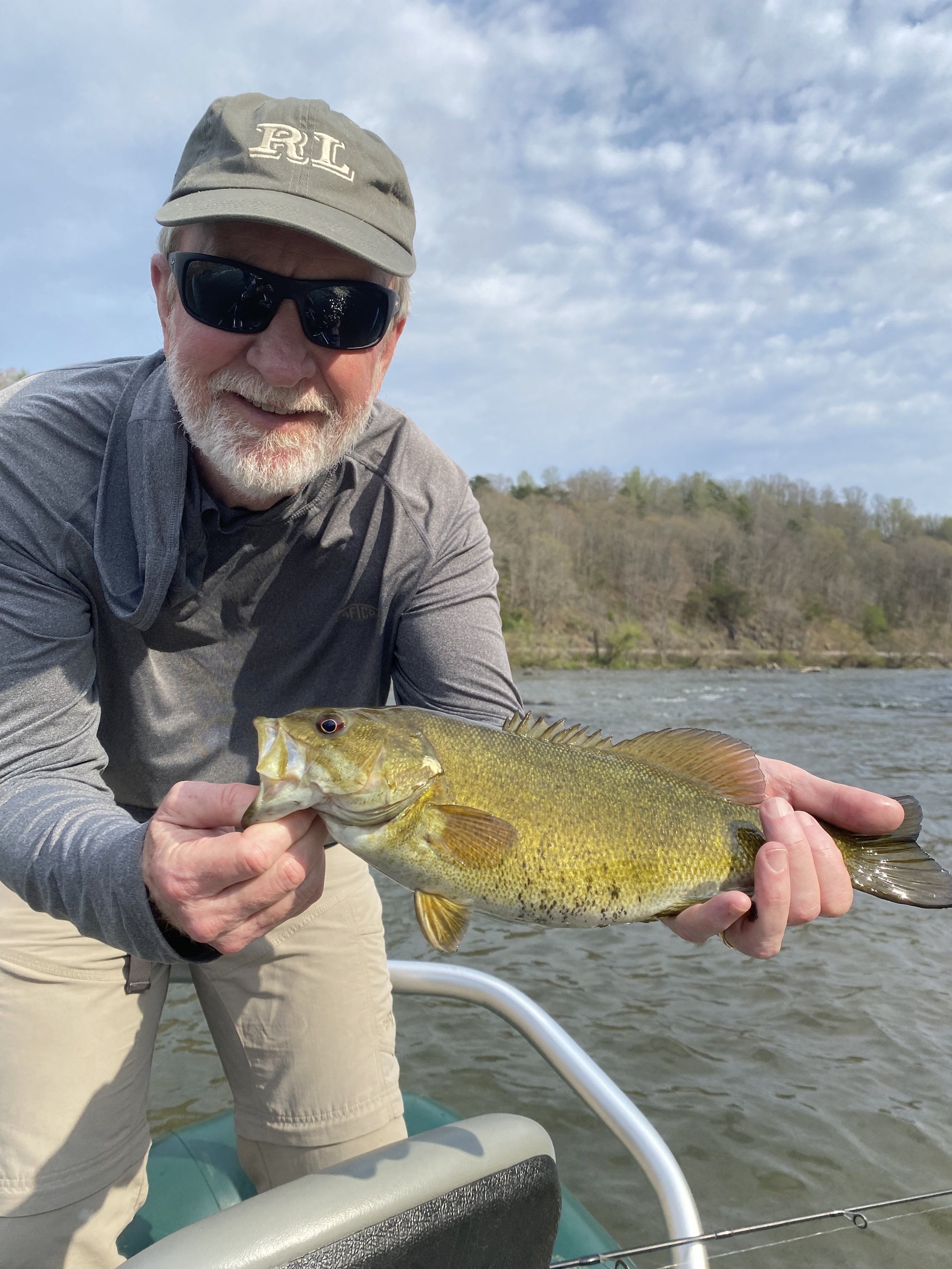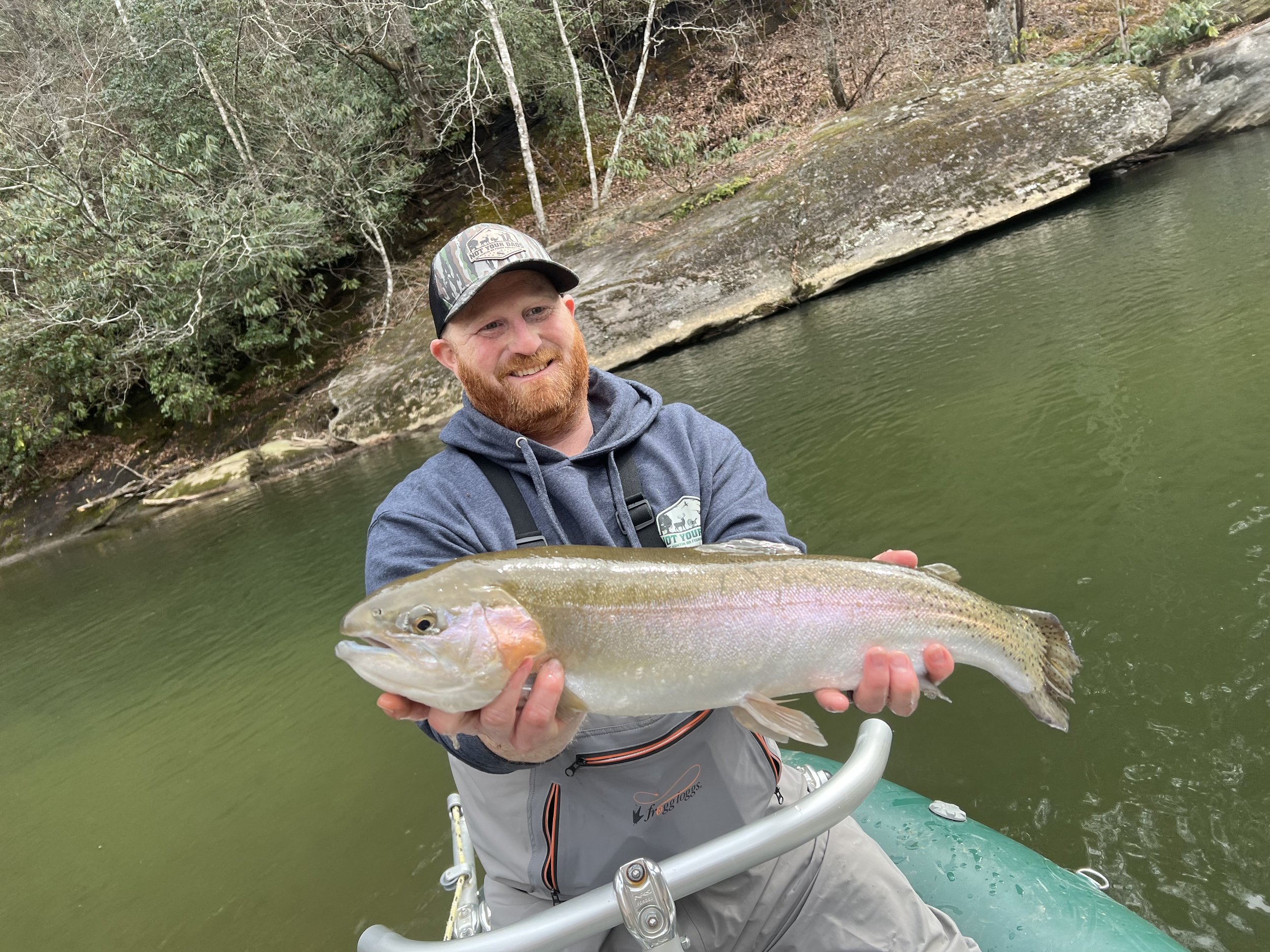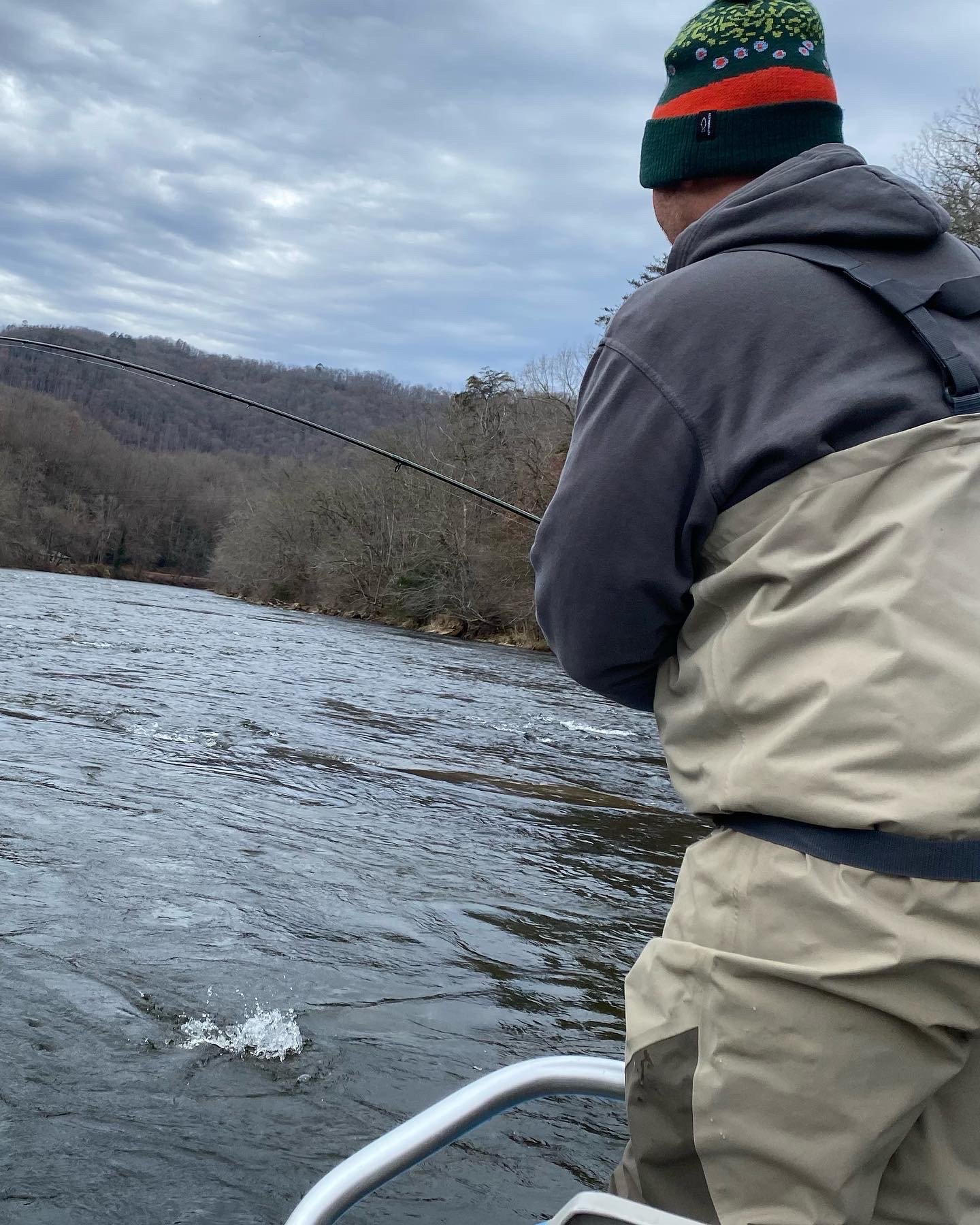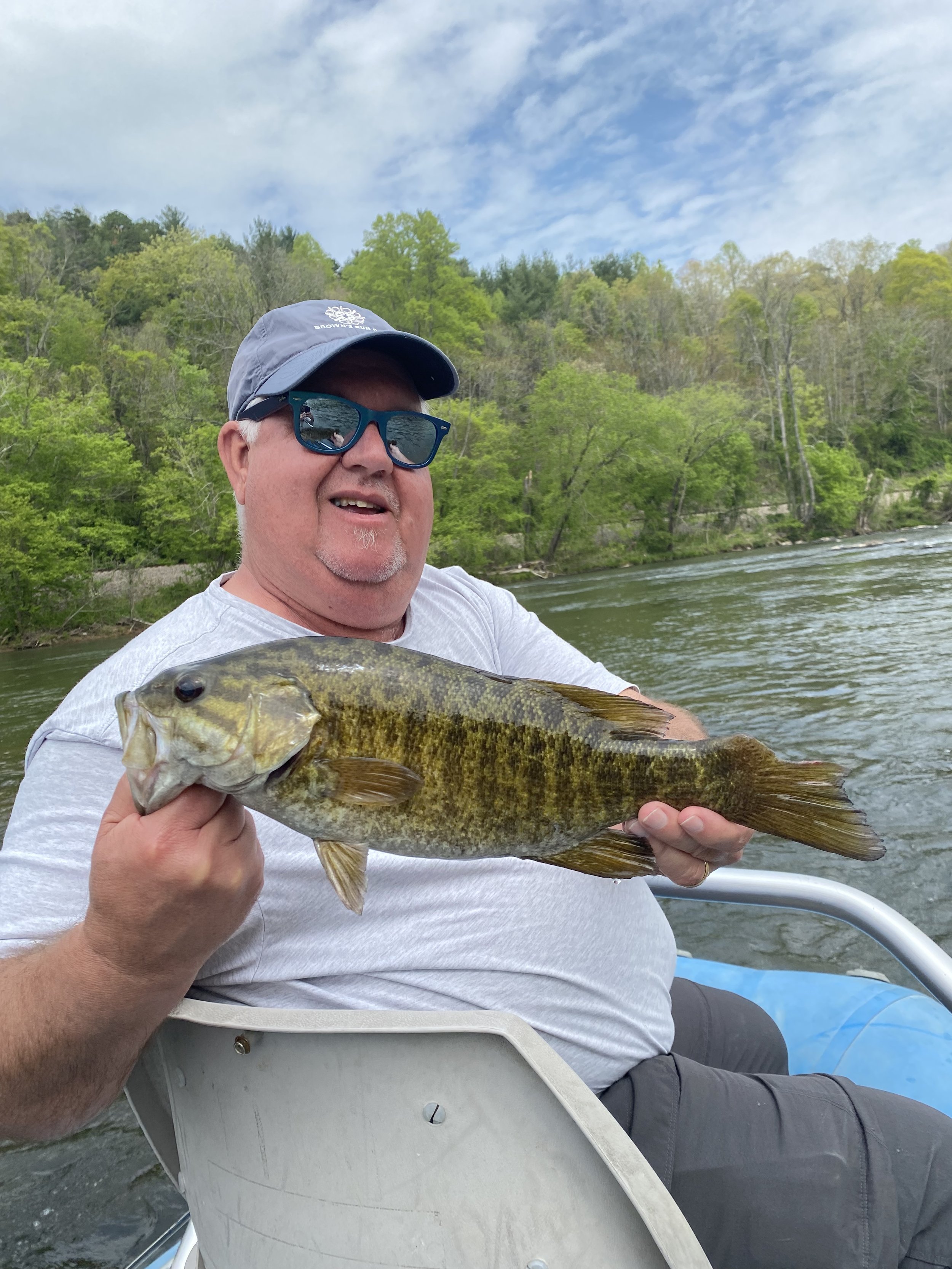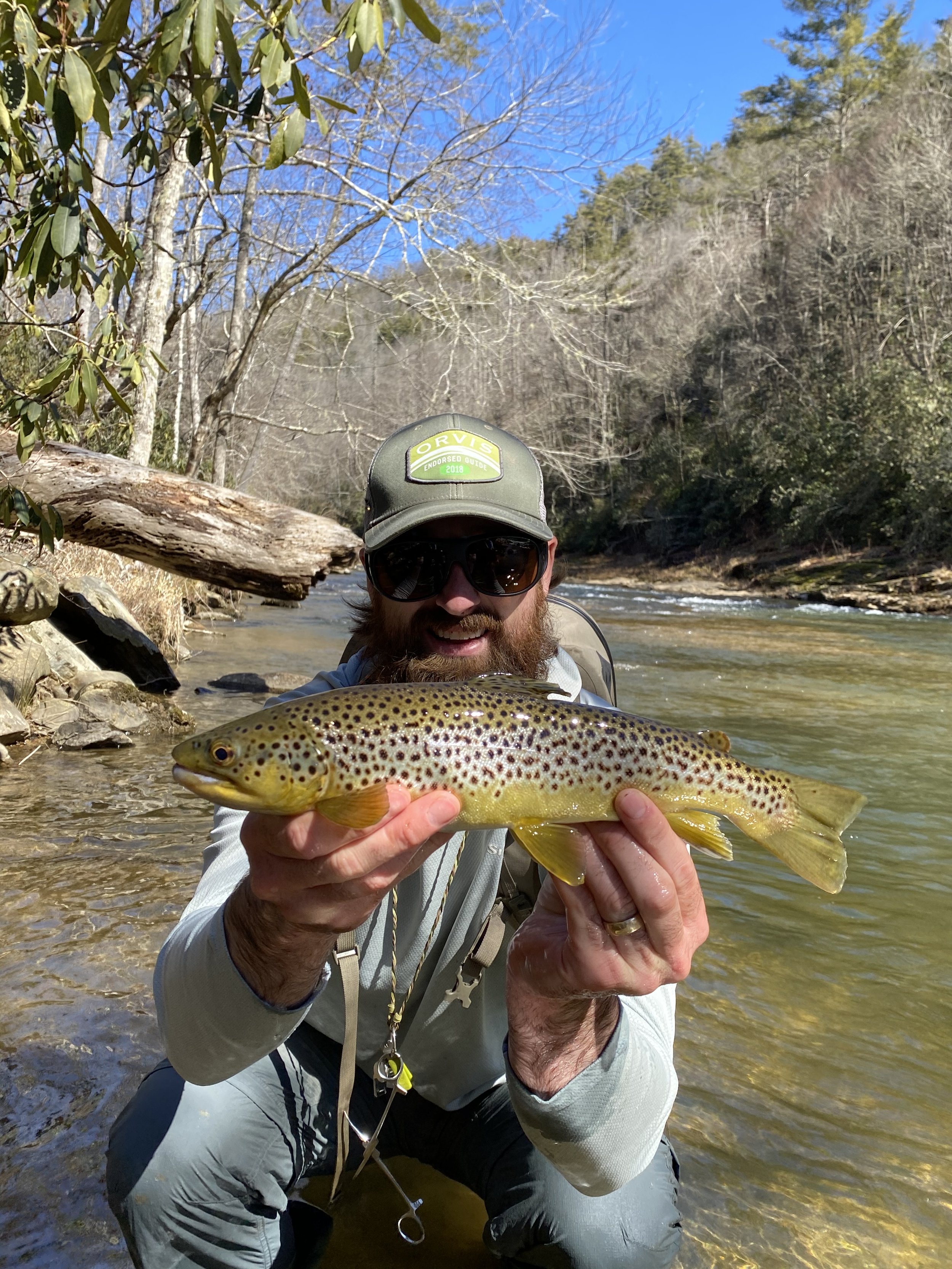Brood XIX cicadas will emerge this May in Buncombe County once the soil temperature reaches 64 degrees. The last time this emergence happened was in 2011 which provided some excellent topwater fly fishing on the French Broad River. Once these bugs emerge the fish will be keying in on them from mid May to mid June. If you are a fly angler and topwater bug fishing is your thing then you don’t want to miss this hatch. This can provide memorable days you will be talking about until 2037 when the next emergence happens. I’ve already got some guys lined up on my calendar for this hatch, but still have some week day openings. Let’s talk!
2024 Western North Carolina Fishing Guide
Below is an informative guide of the best fishing opportunities throughout the year in western North Carolina. This guide will be useful to potential clients wanting to know the best times of the year to book a guided fishing trip with us.
January - February: These two months are overlooked by anglers thinking it’s too cold to fish, but you can catch some big trout during the coldest months of the year. We stay on the lower elevation fisheries and tailwaters where water temperatures tend to stay warmer. This time of the year we throw large stonefly patterns and streamers to trick the biggest fish in the river. Large flies catch big fish this time of year since the dominant fish are looking for the “best bang for their buck” when it comes to eating since their metabolism is low. Dead drifting a stonefly or retrieving an baitfish pattern slowly in the wintertime are highly effective. Our favorite floats in January and February are the Tuckaseegee, Catawba, and the Catawba Tailrace. These three floats hold some large fish that are stocked by the state in October and November. The Catawba Tailrace is a low gradient tailwater that doesn’t produce the same prolific hatches that the East Tennessee tailwaters do except for the caddis and the stoneflies in early Spring, but the main source of food for the brown trout is baitfish. This provides some good streamer fishing opportunities in January and February. This time of year we are looking for quality fish instead of quantity based on the fishing methods we use. The wild trout streams are always a blast to fish in the winter because of the solitude, but the best fishing on these streams will begin in early March when the warmer weather activates the nymph activity. Below are some photos of some quality trout and a big walleye we’ve caught in January and February.
March - May: The best trout fishing of the year happens during these months. This is also one of the best times of the year to catch trophy smallmouth in our rivers. Let’s start with the trout fishing. During these three months we have more insects on the water than any other time of the year which provides excellent trout fishing every day. Our water temperatures during these months correspond to when trout most actively feed which is 55 to 65 degrees. During these months our guides will have dry fly, nymphing, and streamer rods on the boats ready to go since there is so much activity happening on the water. The delayed harvest creeks and rivers provide excellent wade and float fishing opportunities. This time of year anglers can catch both quantity and quality on our guided trout trips. We also offer some more secluded backcountry trips this time of year for anglers looking to get off the beaten path. One of these trips is going deep into the Linville Gorge. This trip is not for the faint of heart and one must be in excellent shape to get in and out of the gorge. The rewards are definitely worth the risk. North Carolina is home to a ton of wild trout streams where fish naturally reproduce. These streams provide a one of a kind fishing experience that highlights what it truly means to fly fish in the mountains of North Carolina. It’s one of our coolest fishing experiences we offer. The wild trout streams fish excellent during this time with the majority of fish caught will be taken on a dry fly. Catching a trout on a dry fly is the epitome of fly fishing in the southern Appalachian mountains. There is an abundance of mayflies and caddis during these months which cause the streams come alive. This time of year is perfect for the beginner who wants to learn the sport of fly fishing since there are so many opportunities to catch. We welcome seasoned anglers looking to learn new skills or fish one of the more secluded rivers we guide on. This is a good reminder to subscribe to our newsletter found on our home page where I provide more in depth fishing reports and subscribers get updates on “hot fishing opportunities” throughout the year. If you want to trout fish then these three months are hands down the best time to do so. We guide on a wide variety of rivers this time of year for trout, but our favorites include the Tuckaseegee, Toe, Linville, Catawba, French Broad, Nolichucky, and the Laurel.
March marks the beginning of prespawn river smallmouth fishing. From early March to the third week of April your chances at catching a trophy smallmouth on the French Broad, Catawba, or Nolichucky Rivers is best. During this time we are focusing on catching trophy smallmouth instead of numbers. By the end of April to the later half of May most smallmouth are spawning so it’s best to not fish during this time. The end of May through June provides great post spawn fishing which is another good opportunity to catch a trophy smallmouth. The bigger fish will actively be feeding trying to put on the weight they lost during the spawn. Both quality and quantity are great during this time. During March through May we offer fly fishing and spin fishing trips for smallmouth. Below are some of the trout and smallmouth we’ve caught during March, April, and May.
June - September: Welcome summertime fishing. These months provide excellent smallmouth fishing where opportunities to catch a lot of fish and big fish present themselves on every float. This time of year also provides the best opportunities to catch smallmouth using a fly rod. Fly fishing with poppers is by far one of the most effective ways to catch a trophy smallmouth hanging out on a shady bank in the heat of summer looking for an easy meal. There are plenty of cicadas and terrestrials around to keep the smallmouth looking up. The majority of our customers prefer to use light spinning tackle, but we love chasing smallmouth using the long rod. There isn’t a better feeling than having a 3 pound smallmouth on the end of the line. The scenery on our smallmouth floats is second to none and it allows clients to see a different side of the mountain region. There truly isn’t a better time to be on the river fishing for smallmouth than the summer months. The wild trout streams fish well into the end of June, but by July it’s too hot to do any trout fishing here in western North Carolina unless we get an abnormal cold front that comes through which can happen towards the end of August. Summertime is the time to try something new and chase these bronzebacks in the river. Trust me you won’t regret it. We’ve had plenty of trout bums give up summer trout fishing and soley focus on catching smallmouth after booking a guided trip with us. Catching a big smallmouth is challenging, but it’s one of the most prized gamefish we have here in western North Carolina. Catching a big smallmouth requires patience, dedication, and a good attitude.
Towards mid September when the first real cold front comes through we will target native brook trout for a brief time before they go into their annual spawn which happens the beginning of October. These fish are gems of the mountains and we handle them with the utmost care when catching and releasing them. The more people we can educate through our guided trips the more people that will support organizations that support the native fish population. Brook trout are our only native fish so it’s our most valuable trout in North Carolina. Our guided brook trout trips involves 4-6 miles of hiking. It’s not for the faint of heart, but like any challenge the rewards are worth it. Some of our favorite brook trout streams are located in roadless areas that are truly wild. Catching these 8 inch fish bring us guides just as much joy when a client catches their personal best trout on a stocked river.
Below are just a few pictures of the great fishing we get to experience in the summertime.
October - December: Welcome Fall Fishing. The fall is personally my favorite time to be on the water. The leaves are changing and the weather begins to cool down after a long, hot summer. The fish notice this change and begin to aggressively feed since colder weather is right around the corner. October is another great month for smallmouth anglers to catch their personal best. Some of our biggest smallmouth ever caught on guided trips come from the month of October. The trout fishing begins to pick up and continues to get better and better as water temperatures begin to drop. The fall is a wonderful time to be on the wild trout streams and the stocked fisheries throughout the western North Carolina region. October is busy on the trout streams since everyone is here for leaf season, but the smallmouth rivers are empty. The trout crowds will die off by November which in my opinion is an even better month than October to trout fish. Water temperatures are lower and the fish get less pressured during that time. Fall fishing is truly magical in the mountains of western North Carolina. November and December offers some excellent opportunities to catch trout without the crowds. Below are some great fish we’ve caught during the fall season.
I hope this guide gives you a better understanding on what to expect over the course of the year on our wade and float trips. If you have more information then simply shoot me an email or give me a call. Our goal at The Catawba Angler is to give you the best guided fishing experience in western North Carolina. None of this would be possible without God. I want to give him all the glory and the praise for giving us the passion for guiding and the physical ability to take you and your family fishing. It will be our pleasure to take you to some of the most beautiful creeks and rivers this side of the Mississippi. Thanks for reading and we look forward to seeing you on the water.
Comprehensive Guide To The Best Fly Patterns For North Carolina Trout Streams
Western North Carolina, with its pristine waters and aquatic life, is a haven for freshwater fly fishing enthusiasts. From the high elevation mountain creeks to the larger freestone rivers, this region offers a diverse range of environments to explore with a fly rod in hand. In this quick guide, we'll delve into the world of fly fishing in western North Carolina discussing the essential fly patterns and techniques that the guides for The Catawba Angler swear by.
Essential Fly Patterns
Pat’s Rubber Legs
Pat’s Rubber Legs are our most productive stonefly nymphs. It’s a great trout fly, but has brought many smallmouth to the net. This should be a staple in every anglers fly box that fishes western North Carolina. You can catch fish on this nymph year round, but the best times fish it is early fall through late spring.
2. Eggstasy Egg Fly
Egg Flys are super easy to tie and they catch fish. The best colors are orange, pink, and yellow. Any egg pattern is great for catching delayed harvest fish during the winter months. Eggs provide big meals that trout have a hard time passing up.
3. Beadhead Pheasant Tail
Beadhead Pheasant Tails are proven patterns that mimic the mayfly nymphs that inhabit the trout streams of western North Carolina. Unweighted pheasant tails are great swinging flies in the spring. This is a must have fly in every anglers fly box.
4. Perdigon Nymph
Perdigon Nymphs get down quick and are our go to nymphs during low and clear water conditions in the fall and winter. These nymphs in size 14-18 will fool the most educated trout in the river. Any natural color is best for this pattern.
5. Parachute Caddis
Parachute Caddis flies are hands down our favorite dry flies for the caddis hatches on the tailwaters of western North Carolina and East Tennessee in the spring. This is a great fly to use during the spring/summer/fall months on the wild trout streams in North Carolina. This is a very buoyant fly to use when fishing the faster pocket water on the higher elevation streams.
6. Chubby Chernobyl
Chubby Chernobyls are great flies to use for dry dropper setups. These flies can carry weighted nymphs better than any other dry fly pattern. The smaller chubbys in size 14-16 are great dry flies for wild trout streams. Our favorite colors gold, tan, and purple.
7. Kreelex Minnow
The kreelex has slowly become one of our most productive trout streamers. The flash of this streamer is very appealing to a large trout looking for a bigger meal. We fish them during the summer for smallmouth bass.
8. Hares Ear Nymph
The Hares Ear nymph is a classic pattern that should be in your fly box. It’s been a staple in our fly boxes ever since we began fly fishing and has proved itself effective year after year. This is a great dropper fly to use under a chubby chernobyl when mayflies are hatching.
9. Griffiths Gnat
The Griffiths Gnat is our go to dry fly pattern when fish are refusing bigger dry fly offerings. It’s a good one to trailer off a bigger dry like a parachute adams if your eyes aren’t as good as they once was. The gnat works great for picking off fish in the slower, deeper runs or the long flats above riffles.
10. Beadhead Krystal Bugger
The Krystal Bugger is a simplistic streamer pattern that has caught fish all around western North Carolina. It’s similar to the wooly bugger but has a lot more flash. This is a great pattern in white, black, and olive.
These ten flies have been effective for us on the trout streams of western North Carolina because they mimic the insects and baitfish that the fish prey on. If you are looking for more information on certain sizes that work best feel free to reach out to us because we are here to help. See you on the water with a couple of these flies on hand! Thanks for reading!
Why Asheville Should Be On Every Fly Angler’s Bucket List
Asheville, North Carolina, is a hidden gem nestled in the heart of the Blue Ridge Mountains. Known for its vibrant arts scene, craft breweries, and breathtaking natural beauty, Asheville also happens to be a paradise for fly anglers. If you're an avid angler seeking new and exciting fly fishing destinations, here's why Asheville should be at the top of your bucket list.
1. Varied and abundant fishing opportunities: Asheville is surrounded by a multitude of rivers, streams, and lakes, offering anglers a diverse range of fishing experiences. From the famous Tuckaseegee River, which is known for its trophy trout, to the productive waters of the French Broad River, where smallmouth bass thrive, there is something for every fly angler's preference and skill level.
2. World-class trout fishing: Western North Carolina is renowned for its exceptional trout fishing, and Asheville is no exception. Within a short drive from the city, you can find some of the best trout fishing in the Southeast. The pristine waters of the Pisgah National Forest and Great Smoky Mountains National Park are home to wild trout populations, providing anglers with the opportunity to catch native brook, rainbow, and brown trout.
3. Year-round fishing: Unlike many other fly fishing destinations that are limited to certain seasons, Asheville offers year-round fishing opportunities. The mild climate in the region allows anglers to fish even during the winter months when many other rivers are frozen. This means you can enjoy the thrill of fly fishing no matter the time of year.
4. Scenic beauty: The natural beauty surrounding Asheville is truly awe-inspiring. The region is dotted with picturesque mountains, rolling hills, and lush forests, providing anglers with a stunning backdrop while they fish. The sight of the mist rising from the rivers in the early morning or the vibrant colors of the fall foliage will make your fly fishing experience in Asheville unforgettable.
5. Knowledgeable local guides and outfitters: Whether you're a beginner or an experienced angler, having a knowledgeable guide by your side can greatly enhance your fly fishing experience. Asheville is home to a plethora of experienced guides and outfitters who are passionate about the sport and the area's natural resources. They can provide valuable insights, tips, and techniques to help you make the most of your time on the water. The Catawba Angler is one of the best fly fishing guides in the Asheville area and will ensure you have a guided fly fishing trip of a lifetime.
6. Excellent smallmouth bass fisheries: The French Broad and Nolichucky Rivers are the best smallmouth rivers in North Carolina. Asheville just happens to be within close driving distance of both. On one of our guided fly fishing trips anglers can immerse themselves in the state’s stunning natural beauty. The solitude we find in the river during the summer is unlike any fly fishing experience in the South.
Western North Carolina Fall Fishing Report 2023
Western North Carolina is in a moderate drought without any rainfall in the 10 day forecast. There are a lot of wild trout streams outside of Asheville that I never seen as low as they are right now. The low water has been challenging, but there some things you can do to give yourself the best chance at catching fish. The top things you can do that will help you catch fish in low water is to use longer leaders, downsize your tippet, and take off the heavy indicators.
I recently guided a client on a wild trout stream here in McDowell County and there is a long flat where some bigger wild rainbow trout post up. If you get up on the hole then those fish will immediately spook. This is typical of any wild trout but in low water conditions it is more heightened. I told the client I was going to lengthen the leader and they were shocked because we were already fishing a 12 foot long leader. I extended the leader to 16 feet and we threw a size 14 parachute caddis as the indicator and small midge as the dropper and hooked three trophy fish. The fishing was technical, but not impossible. We both walked away satisfied with the success of being able to trick those fish into eating our flies in tough conditions. The key to success was lengthening the leader. The longer the leader the better. Once you get familiar with fishing a longer leader you won’t ever go back to fishing the common 9 foot leaders. The advantage is getting your flies out in front of the fish without them seeing your fly line. When you are wade fishing, position yourself where you can cast in front of the fish without them seeing your fly line.
I’ve recently been using nothing but 6x tippet on all trips for my droppers. The 3 pound fluorocarbon is plenty strong enough to hold bigger fish. The key is to check your line after snags or a landed fish. Any fray in your tippet is a recipe for a missed fish.
Using smaller dry flies as indicators have been great because indicators make a huge splat on the water which spooks fish before you have even given yourself a chance at catching them. Some of my favorite indicator flies to drift nymphs under are parachute caddis, chubby chernobyls, and hoppers.
Doing these three things in low water conditions will up your chances at catching fish.
The best float fishing has been on the Tuckaseegee. We’ve been over there because the Catawba and the North Toe Rivers are just too low to successfully float fish right now. If you want to fish these rivers then it would be best to wait till we get some rainfall. The Tuckaseegee has been fishing well and we’ve seen some decent dry fly fishing in the afternoon. Stocked fish will eat dry flies! It’s cool teaching clients something other than nymphing on our trout floats. I’ll always have a dry fly rod and streamer rod in the boat because of all the different water types you encounter on floats. We were recently on the French Broad near Hot Springs and we got into some awesome dry fly fishing for smallmouth. We caught a pile of 6-8 inch smallmouth. The fish were feeding on blue wings nonstop one afternoon. After throwing crawfish patterns all day my clients were happy to see some topwater action. Below is one of the many we picked off top. I say all this to say always be ready to adjust based on what you’re seeing on the water. Paying attention to the small subtle clues that the fish and bugs give you go a long way.
The leaves are quickly falling and this can make fishing challenging as they float through our systems. This is a great time to fish heavier nymphs such as pats rubber legs or beadhead eggs that punch through the leaves better than your smaller nymphs. I also like to throw weighted buggers this time of year on the bigger rivers to get down into the slower moving water where there isn’t much leaves. Most of the leaves stay right below the surface since that’s where the fastest current is. If there are a lot of orange, red, and yellow leaves floating through then try fishing a white or black pattern that shows up better to the fish in the array of colors.
The smallmouth fishing was challenging this fall, but also really good. The challenge came from the grass that was present in the French Broad. Our normal hardbaits that we throw in the fall wasn’t possible because every cast they would grab big chunks of grass but we were able to trick some big fall smallmouth into eating some non traditional baits. We are wrapping up our smallmouth season since tomorrow we have a freeze warning here in Asheville. The lower water temperatures will slowly shut down the bite unless you want to fish a few hours in the afternoon which provides the warmest part of the day. The smallmouth fishing on the French Broad and Nolichucky Rivers was excellent this year. We learned a ton and caught some trophy smallmouth on both rivers. We look forward to seeing our clients again in March. Below are some of the best fish we caught this year.
The trout fishing is good currently, but we desperately need some rain. We plan on floating the Tuckaseegee River until we get get some rain that will bump up the flows on the Catawba and Toe Rivers. We are also looking forward to fishing the Catawba Tailrace this year. I’ll be updating everyone on how that fishery is doing towards the end of November. Fingers crossed we get a good stocking and they are able to spread the fish out. Below are some trout we’ve caught this early fall.
GUIDE: ASHEVILLE FISHING CHARTERS
Asheville Fishing Charters offer some of the best ways to enjoy your visit to Asheville, North Carolina.
There are ample opportunities to explore the productive smallmouth and trout rivers in Asheville by boat or foot.
The Catawba Angler is led by head guide Matt Evans who has spent his whole life fishing the smallmouth and trout streams in western North Carolina. It’s our mission as a company to provide the best fishing trip possible. We will do everything in our power to provide clients with an memorable fishing experience here in the mountains of North Carolina.
There is always something to catch here in North Carolina whether it be wild trout on a backcountry stream, stocked trout on a bigger freestone river, or smallmouth on the French Broad or Nolichucky rivers. We welcome first timers looking to learn the sport of fishing or experienced anglers looking for their personal best smallmouth or trout.
The Catawba Angler offers half day and full day trips. Half day trips are good for parents with younger kids or the angler who is limited on time. Full day trips are great for experienced anglers wanting to fish longer than the half day. There are multiple benefits to a full day trip such as more fishing time, covering more water, and a full day is only $100 more than the half day rate. Certain times of the year the fishing is more consistent which justifies a full day trip, but there are times where fishing is best certain hours of the day which in that case the half day trip would be best. Whatever guided fishing trip you decide we promise to make it an unforgettable time on the water.
We are fortunate to be able to run guide trips every month of the year here in Asheville. The best time to trout fish is October through the end of June. We do offer wild trout trips throughout July and August, but clients must be willing to go early in the morning and capable of fishing higher elevation trout streams where we can find cold water. Smallmouth fishing is great from March to November. Every month is different. Experienced anglers looking for bigger fish, the spring and fall months would be best. During this time we throw bigger baits and flies for the larger smallmouth. It’s not uncommon to catch 50 smallmouth on a full day trip during the summer, but every day is different. We’ve had 100 fish days when the stars align on the French Broad River. As a client enjoy the process of catching and not just numbers. You can trust your guide that is out there every day that they are working off knowledge that has been acquired over many years. I don’t know any guide that doesn’t want their clients to catch fish. I can assure you that myself and any other guide that works for The Catawba Angler has put in the leg work to give you the best fishing trip possible no matter the conditions. Our guides understand the seasonal patterns and weather conditions that affect fish behavior, which helps us fish more effectively.
There are days that can be more challenging than others and we will celebrate the small wins that day, but just know we will give you our very best day in and day out.
The Catawba Angler offers fly fishing and spin fishing trips for trout and smallmouth. Fly fishing for trout and spin fishing for smallmouth are the most effective ways to target the two species. We will spin fish for trout and we will fly fish for smallmouth. We are in the business of making the client happy and prepared to fish whatever way you are most confident in. If you want to fly fish for smallmouth our favorites times to do so is July/August/September. This time of year we throw topwater flies for the bigger smallmouth looking for an easy meal. Fly fishing is the best way to dead drift a cicada pattern against a shady bank targeting bigger fish. We only fly fish for the smaller wild trout. These smaller trout are willing to hit dry flies most months of the year. Fly fishing is ideal when presenting smaller flies.
The Catawba Angler is capable of handling large groups on guided fishing trips, but smaller group sizes is always ideal. Think about it. If you are the third boat of your group fishing behind two guide boats most likely your boat is not going to have as productive day as the two boats in front. We do our best as guides to leap frog each other for your parties sake, but someone is always going to get the short end of the stick. It’s best to keep your party to two anglers at a time. I understand people have bigger families especially ones with kids. If all the kids want to go we will gladly guide them on one of our family friendly fishing trips here in Asheville. We enjoy guiding the next generation as much as seasoned anglers.
It’s hard to read a website and get all your questions answered. If you are interested in booking a guided fishing trip we encourage you to email, call, or text us. You will be speaking directly with Matt Evans (Owner/Head Guide of The Catawba Angler). He will gladly answer all your questions and tell you what is fishing best that time of year.
Asheville and the surrounding areas are some of the prettiest places in the Southeast to fish. The Catawba Angler is your ticket to an Asheville fishing adventure. We look forward to showing you the best trout or smallmouth fishing in Asheville.
Fly Fishing in Asheville with Kids
Fly fishing in Asheville with one of our guides is an excellent way to show your kids the value of spending time outdoors. They get to learn a new skill that could eventually turn into a hobby they can do their entire life. We live in a world where technology rules, but there is nothing better for a kid to put their phone or video game down for a few hours and enjoy the beautiful creation that God has provided us with. The Catawba Angler welcomes kids of all ages to join us on our fishing trips in Asheville. If your kid has never done fly fishing before then we are happy to teach them the essentials that they can carry with them throughout their fly fishing journey. We also offer spin fishing trips for kids as well. Our guided fly fishing trips in Asheville are fun activities for a parent and child to do on Spring, Summer, or Fall Break. Both children and adults need to spend time outdoors because those who don’t have a higher risk of not appreciating the environment, more health problems, and higher rates of anxiety. We have guided kids as young as five years old and have had a blast doing it. We do require every child to be accompanied by their legal guardian. Your kid’s safety is our priority. Our guided fishing trips in Asheville provide everything you and your kid needs to have a successful day on the water. If you have any questions on what’s the best fishing for your kid just give us a call at 828-460-2390 and we can customize your fishing trip based on your needs and wants. We look forward to fishing with you and your family in Asheville.
Fishing the French Broad and Nolichucky Rivers for Smallmouth Bass
The Nolichucky and French Broad Rivers provides the best smallmouth fishing in North Carolina. The rivers are in close proximity to Asheville which provides plenty of entertainment for the whole family after a day of floating down one of these scenic rivers. The Catawba Angler is a fly fishing and spin fishing guide service in Asheville that offers guided float fishing trips for smallmouth bass. The French Broad is big and wide which makes wade fishing very difficult, but those who have rafts can fish plenty of water that isn’t accessible by foot. These two rivers begin fishing well in March and will continue all the way into early November. The French Broad has more quality fish in it than the Nolichucky, but if your looking for numbers then the Nolichucky is the way to go. When the French Broad is clear I can’t think of a better river to be on in western North Carolina. If you are interested in booking a guided smallmouth fishing trip then give us a call and we can discuss which river would be best based on your preferences. We offer full day trips for $450 and half day trips for $350. These trips are great for beginning and experienced anglers. We also offer kid friendly fishing trips on both rivers as long as the kid(s) are accompanied by an adult. We look forward to guiding you while you visit the mountains of North Carolina.
Below are some of our most recent catches on the Nolichucky and French Broad Rivers.
Summertime Fishing Report
The smallmouth fishing on the French Broad and Nolichucky rivers has been excellent as of late. Day temps have been unusually cool this summer so water temperatures have yet to exceed 73 degrees on the Nolichucky and French Broad. We’ve had a few great days of topwater fishing using flies and lures, but I think the best topwater fishing is in the near future once the cicadas begin to come out. The rivers are currently high from the most recent rain event we had, but expect the fishing to be lights out once they drop to their normal summertime flows.
The Catawba Angler was recently featured in the Carolina Sportsman which was a complete surprise to me. Big shoutout to Brian Cope for writing the article and highlighting the great fishing on the Nolichucky River. If you’re interested in reading it then click the link below.
https://www.carolinasportsman.com/fishing/bass-fishing/catch-bronze-on-the-nolichucky-river/
We’ve are still fly fishing for wild trout as long as water temperatures continue to stay below 70 degrees. If you book a fly fishing trip for wild trout then expect to start around 6:30am or 7am. This allows us to safely catch and release these fish while water temperatures are still in the safe range. Terrestrial fishing is good on the wild trout streams so if your interested in throwing dries to rising trout then give us a call.
I want to thank God for continuing to grow this business and allowing me to pursue fishing as a career. He worthy of all my praise.
Psalm 145:1-2
Smallmouth Fly Fishing Guides
The summer months in North Carolina provide great fly fishing opportunities for smallmouth bass. The best time to fly fish for smallmouth using topwater flies is June, July, August, and September. There are plenty of cicadas, damselflies, dragonflies, and terrestrials that these fish feed on all summer long. These bugs are easy meals for the smallmouth to pick off the top of the water. Some of our biggest smallmouth of the year come on topwater poppers when fishing the shady banks during the hottest days of the year. These bigger fish push to the banks to find shade and it’s hard for them to resist a well presented bug. The subtle presentation of a topwater fly is hard to beat when the water is low, and the bigger fish are spooky. It’s always best to have a variety of colors of topwater flies because smallmouth can become very picky on what they want to eat. Colors that are always in my box for topwater flies are chartreuse, white, black, and Carolina blue. The Carolina blue poppers mimic the blue damsel flies on the French Broad and Nolichucky Rivers very well. Fly fishing for bass using topwater flies is not easy. An angler needs to be able to double haul and cast a respectable distance using a 6 or 7 weight rod. Most casts will be over 40 feet so this can be taxing if one isn’t prepared. Catching a three pound smallmouth on a topwater fly is tough, but the effort is so worth it. There are a lot of external factors that have to come into play to have a good day using topwater flies. The water needs to be low and clear and the water temperature needs to be 60 degrees or higher. A smallmouths ideal feeding temperature is 60-80 degrees. Anytime the water temperature is in the range then you can catch smallmouth on top. Fly fishing the French Broad and Nolichucky Rivers near Asheville is one of our favorite things to guide clients on during the summertime.
Fishing near Charlotte, NC
There are some excellent fisheries that are within 2 hours of the Piedmont area. In this article we will highlight some the best fishing near Charlotte. The majority of clients that fish with us year after year are from Charlotte. The fisheries that we will highlight below are within 100 miles of the “Queen City”.
The Catawba Tailrace
The Catawba Tailrace is a brown trout fishery that is 82 miles from Charlotte. This is close striking distance for the Charlotte angler looking to make a day trip to fish. The Tailrace is often overlooked because when you think of the Catawba River you don’t necessarily think of trout. The cold water discharges from Bridgewater Dam in Morganton provides water cold enough to support a year round trout fishery. The hot summer months of August/ September can be tough on the fish, but the majority of brown trout that gets stocked by the NCWRC in the fall have high chances of surviving since their water temperature tolerance is higher than the rainbow and brook trout. The fish that survive year after year here can grow to substantial sizes. Not only can you catch brown trout here, but certain times of the year the Tailrace offers striper and walleye fishing. The best way to fish this stretch is to float it with a raft or drift boat, but anglers can wade the upper stretch of the Tailrace when they aren’t releasing water. If you are interested in this fishery and would like for someone to show you the ropes then we would be happy to guide you on this great tailwater. Below is a picture of a trophy brown trout that came out of the Tailrace.
The Catawba River
The Catawba River provides some of the best fishing near Charlotte. It’s one of the most diverse rivers in the state for number of fish species. The majority of anglers that fish it chase trout, bass, perch, and catfish. The Catawba River begins in the mountains and eventually makes its way through the Charlotte metropolitan area. You can’t have a list of the best fishing near Charlotte without mentioning the Catawba River. The Catawba is the river that I named our guide service after because it holds a special place in my heart. I grew up within walking distance from the river and have fished every mile of it from Old Fort to Charlotte. Without the Catawba River then the 7 great bass lakes that form the chain of lakes wouldn’t exist. The best trout fishing is from Old Fort to Morganton, NC. Heading east from Morganton there is good striper and largemouth fishing around Granite Falls. Downstream of Granite Falls you get into some good bass/perch/catfish fishing. We specialize in guiding on the Catawba River where it runs through Old Fort, Marion, Morganton, and Glen Alpine. If you want to experience some of the best fishing near Charlotte then check out the Catawba.
Linville Gorge
The Linville Gorge is 110 miles from Charlotte. This is one of the most rugged gorges on the east coast and it should be on every anglers list of places to fish if you live in Charlotte. If you’re looking for seclusion and good fishing then this is the place to go. It’s not for the faint of heart, but fishing in the Linville Gorge is so rewarding. It’s therapeutic. It’s a place that shows you how majestic our God truly is. Only God could create a place so rugged, vast, and beautiful all at the same time. The hike into the gorge will challenge you and the fish can be hard to get to, but the biggest brown trout I’ve ever caught in NC came out of the Linville Gorge. We have guided a few clients over the years here and I’ll say every single client loved it whether we caught fish or not because it’s all about the experience. The fish we have caught down in the gorge rivals some of the brown trout you see out west. If you are up for tackling the most challenging fishing trip you’ve ever been on then let us know. We chase trout in the spring months and smallmouth in the summer.
Wilson Creek Gorge
Wilson Creek flows through the heart of the Pisgah National Forest and is a great location for someone in Charlotte looking to make a day trip to chase trout. Wilson creek gets stocked with trout every fall and spring and offers many opportunities to catch some large trout. The tributaries that flow into it have healthy wild trout populations. There are so many wild trout streams in the Wilson Creek area that a man/woman couldn’t fish it all in a lifetime. This is a fly fishers paradise. We will guide here only on special requests. The Gragg Prong and the two forks of Harper Creek are worth checking out when visiting this area.
There are plenty of great fishing spots around the Charlotte area, but if you’re looking to get away from the city then look no further at the spots above. They are all worth checking out the next time you’re looking for a fishing adventure near Charlotte.
Late Spring/Early Summer Fishing Report 2023
It’s currently May 8th and we have been spending most of our days trout fishing, but the smallmouth bite has been heating up and we couldn’t be more excited. We are still experiencing excellent float fishing on the larger stocked trout rivers such as the Catawba River through Marion, the Tuckaseegee River through Dillsboro, and the Toe River through Spruce Pine. These larger stocked rivers are fishing well and will continue to fish well until the end of May. After the end of May we will be focusing our attention to wild trout and smallmouth bass. We will touch more on that later in this article.
We’ve had a ton of success this Spring wading and floating the delayed harvest creeks and rivers. I want to thank all the NCWRC workers who stock these creeks and rivers because without them we wouldn’t have these great fishing opportunities here in the mountains.
Early spring 2023 has provided some stellar nymphing, dry flying, and streamer fishing days on the Tuckaseegee and Catawba Rivers. We saw alot of low water days on the Tuck which made for some fun dry fly fishing. The higher water days provided great streamer fishing using sculpin and leech patterns. The Catawba River through Marion has seen a good amount of rain so streamer fishing has been fantastic a few days after the rain storm. There are a ton of 10-14 inch rainbows in this stretch with some bigger ones mixed in. The Toe River has been consistent since the fall and has been one of our most productive stretches for numbers of fish. Below are some of the few photos we have from the delayed harvest stretches in North Carolina. These stretches provide the best trout fishing in North Carolina from October to May.
The wild trout fishing has been great in our neck of the woods. We’ve been catching fish on an assortment of dry flies and nymphs.
I recently had a day in early May with some longtime clients where the sulphurs were going off like I’ve never seen before. I couldn’t get them tied onto my clients rods fast enough. We fished that hatch for about an hour and it was fish after fish since that’s what they were keying in on. That’s one of those moments where you had to be there to fully appreciate it.
The wild trout fishing will continue to be great until the water temperatures hit the upper 60’s. Ideally the best time to fish wild trout streams is when the water temperature is between 45-65 degrees. We monitor the water temperature each trip because the worst thing is anglers can do is go fish a wild trout stream when the water temperature is too hot. The good news is that we don’t see water temps hit the upper 60’s until summer so we’ve got a lot of great dry fly fishing until that time. If you’ve never experienced a wild trout fly fishing trip then consider booking one with us. This is an excellent way to better your casting and presentation skills. These wild trout normally give you one opportunity to catch them. If you don’t succeed on the first opportunity they give you at catching them then it’s best to move to the next hole. These are wild trout born in the stream so they are more in tune with what’s going on around them than stocked fish. On our wild trout fly fishing trips we take the 3 weight rods and cast dries all day and we will tight line the deeper holes looking for that 12-14 inch wild trout. Most fish are smaller on these creeks but what they lack in size they make up for in beauty. Check out some of the pictures from our recent wild trout fly fishing trips.
Float fishing for smallmouth bass is one of the best fishing trips you can take in North Carolina. We are close to coming out of the spawn on the smallmouth rivers. Some fish have already finished doing their thing and are looking for any available meal to put on the weight they lost during the spawn. The smallmouth bite will get better and better as water temperatures continue to warm. I tell clients the best time to smallmouth fish is May through October. If you haven’t experienced the smallmouth fishing in western North Carolina then you are missing out on a special fishing experience. The scenery is good. The fishing is good. The crowds are nonexistent. What more can an angler ask for in a fishing trip? We offer spin fishing and fly fishing trips for smallmouth. Contact us with any questions on when to schedule your smallmouth trip. Check out some recent pictures from our smallmouth trips.
We’ve got some new hats on the way to celebrate that smallmouth season is here! We will be selling them for $30 a piece. Let me know if you want one and we will make it happen. The image below is a sneak peek of what we came up with for the design this year.
Fly Fishing the Tuckaseegee River
The Tuckaseegee River is the one of best stocked trout rivers in western North Carolina. It’s delayed harvest stretch between Sylva and Dillsboro gets stocked twice in March, April, May, October, and November. These stockings provide an abundance of trout to be caught from October to the end of May. After the first Saturday in June most of the fish are harvested by anglers since the delayed harvest designation turns into a hatchery supported designation. Anglers can can keep 7 trout a day while fishing hatchery supported waters.
The Tuckaseegee River can be very crowded with fishermen during the spring and fall months, but it’s a big enough river where wade fishermen and boaters can spread out. The river is wide and open for longer casts making it an enjoyable experience fishing from a drift boat or raft.
Our favorite methods for fishing this river is swinging wet flies during hatches, and stripping streamers off the banks during higher flows. Low water days can be a lot of fun in the Spring throwing dry flies when a compound hatch is going off. Drifting nymphs under an indicator can be super effective as well. A lot of anglers use indicators to dead drift bugs through runs so it can payoff to take the indicator off and switch up your presentation when the fish are being picky. Swinging unweighted pheasant tails and soft hackles are hard to beat. Most anglers tackle this river with a five weight rod since it’s versatile for throwing dries and nymphing. A seven weight with sinking line or a sink tip is great when both forks are being released to get those streamers down in the water column.
The Tuckaseegee River boosts high numbers of fish and quality ones at that. Anglers can get their trout slam here by catching a brown, rainbow, and brook trout in one outing.
It’s always a pleasure fishing the “Tuck” with clients because I get to share the memories and stories I made on this river when I was at Western Carolina University. I used to fish it every chance I could get when i could catch a break from my studies and competing on the track and field team. The river is always a peaceful place no matter how many people are fishing it and it’s a special place to trout fish here in the mountains of North Carolina.
Prespawn River Smallmouth in North Carolina
Springtime offers some excellent smallmouth bass fishing here in the mountains of North Carolina. Most anglers are focused on catching trout in the creeks and rivers that are stocked, but I would like to encourage you to consider chasing bronzebacks in the spring.
Normally by the second week of March the river smallmouth are moving out of their wintering holes and starting their annual prespawn ritual which involves bulking up for the spawn. The spawn normally begins towards the later half of April and extends well into May. Over the past two years the spawn has ended the second/third week of May. Most of the fish we catch during this time have spawned out. All the weight the fish packed on during the prespawn is worked off during the spawn.
The best prespawn fishing occurs when the water temperatures reach 50 degrees in mid March and lasts until the end of April. Once the smallmouth are solely focused on spawning they aren’t actively eating. The good news is that the post spawn bite begins towards the later half of May and fishing will be great till the end of October. Normally smallmouth bass fishing peaks on our WNC rivers the second week of June.
We are throwing a variety of baits and flies for prespawn smallmouth. This is the time fly anglers can get by with throwing 4-6 inch streamers on sinking lines. River smallmouth need to put on as much weight as possible after being in a lethargic state of mind all winter long. Don’t leave the house without some sort of crankbait, swimbait, or suspending bait. The key to catching fish in the Spring is slowing down your presentation. You’ve got to realize that everything in the river is moving slow.
There is a time and place for fast retrieves but that’s during the summer. One of our favorite streamer patterns in the Spring is the feather game changer. This is must have fly in every smallmouth anglers fly box.
North Carolina has some of the best smallmouth rivers in the South and the prespawn period offers anglers the chance of catching a trophy smallmouth. Below are some of our best catches in March and April.
April Fishing Report 2023
April has been nothing less than spectacular! Our guides have been chasing trout and smallmouth every day. The Catawba Angler provides fly fishing and spin fishing trips for trout and smallmouth in Asheville. Give us a call to get in on the action this year. We welcome experienced and novice anglers. We can customize a fishing trip in western North Carolina that fits your needs. Enjoy our recent catches from some of the best rivers in North Carolina.
Lake James Smallmouth
Our head guide Kelsey Minish caught this 5.5 pound smallmouth on a recent trip at Lake James. (April 2023)
North Carolina Fishing Report March 2023
March 20th was the first day of Spring. It’s currently 74 degrees in Asheville. The caddis and march browns were coming off the Tuckaseegee River this past weekend. The Catawba River is loaded with hungry rainbows. The French Broad and Nolichucky smallmouth are in their prespawn phase bulking up for the spawn. The wild trout streams are waking up from winter and offering good fly fishing. Life is good for anglers and guides here in western North Carolina.
We’ve got a few dates left in April, but we are currently booking in May and June so do not hesitate to get on our calendars. I recommend people to book at least 3-4 weeks in advance. We can handle last minute bookings, but if you want a preferred date contact us early.
The French Broad smallmouth were on a crayfish pattern this past week with water temperatures around the mid to upper 40’s.Water temps are 60 degrees currently so fishing will be good until the fish concentrate solely on the spawn.
We have had some stellar days on the delayed harvest waters. Float fishing has been best because we can cover so much more water than wade fishing. The delayed harvest waters will be excellent till the end of May. Check out some of these great fish from our recent floats.
We been wading some new stretches of river which has been fantastic. We were on a local river in McDowell County and got into some excellent brown trout. The are healthy, hard fighting fish which makes for a great day!
As March comes to an end we are heading full steam into April. The Delayed Harvest waters are full of trout and after the first Saturday in April the Hatchery Supported Waters open up. We have some wading and floating opportunities that we haven’t been able to access due to the waters being closed so after the first Saturday in April let’s go chase some fish on some waters that have been closed a month long. Below is a brown trout from a hatchery supported section we are able to float in April and May.
Winter Fly Fishing Report & Outlook for Spring 2023
Winter is on its way out here in the mountains. We’ve seen plenty of 50 degree days in January and now we are starting to see those 60 degree days. These warmer trends have provided excellent fishing on the Catawba, Davidson, Tuckaseegee, and Toe Rivers. We have spent the majority of our time in the boat this winter, but have had some excellent days wading the Catawba. There are plenty of winter stones on the water so plenty of fish have been eating pats rubber legs in black and brown. The pats rubber legs is a confidence pattern for me during the winter. It’s proved itself over and over, year after year on these mountain rivers. Another productive fly has on the delayed harvest rivers has been orange sucker spawn eggs with a gold bead. If you can’t catch them on the pats or the egg then most likely the fish want something a lot smaller so that’s when you try your midges, pheasant tails, or flashy bead head nymph patterns. The smaller flies below have been productive for me on the DH section of the Catawba and Tuck.
We’ve been catching a bunch of rainbows and a few browns on the Catawba since that is the majority of the fish that were stocked this past fall. The Catawba, Tuckaseegee, and Toe Rivers will be receiving its first stocking of 2023, the first week of March so trout fishing here in the mountains is about to be lights out. We’ve got plenty of wadeable creeks and bigger rivers to fish for trout during March, April, and May. The fishing in the spring is consistent all day long because of the suitable water and air temps. If you’ve been wanting to book a guided trip, but have been on the edge of deciding I would like to encourage you to book. As a company we have decided not to raise prices this year for our half day and full day floats. Our half day floats are $300 and our full day floats are $400. I have decided to do this for the people who doesn’t have alot of disposable income. When I started my business in 2017 I wanted to make guided fishing trips in western North Carolina available to everyone no matter their income. You have my promise that our guided trips are the highest quality trip in western North Carolina even though our prices are the most reasonable. We understand clients work hard to book trips and so our promise to you is that we will do everything we can to give you the most memorable fishing experience in WNC. Let’s get back to fishing. The Catawba River is a beautiful stretch of water that holds a good amount of stocked fish. The stretch runs through small sections of private land that isn’t accessible by foot so these areas yield a bunch of fish. If you are a beginner wanting to book your first float trip and learn the ropes of fishing from a boat then this stretch is for you. Check out some of our most recent catches from the Catawba.
The Catawba River also provides great wade fishing opportunities as well. On the warmer days we have been taking advantage of wading the river with clients.
We provide all the waders, boots, rods, reels, and flies for our wading trips. We offer half day trips for $300 for two anglers and full day trips for $400 for two anglers. We are able to guide up to six anglers on guided trips using three guides. We prefer to put two anglers per guide so both anglers are getting the special attention they deserve.
We’ve been guiding on the Toe River this winter which has been excellent. This is a secluded stretch of water that isn’t the easiest to get to, but that is what makes it special. If you are interested in floating this stretch let us know. Check out this 25” bruiser our guide Jason Wilson put his client on last week.
The Tuckaseegee River always fishes well in the winter because it gets stocked in October, November, and December. We prefer to fish this river in the winter because it’s less crowded then and it’s a great time to rip big streamers for big fish. It will be getting stocked again in a couple of weeks so it’s a great option to fish this spring. Below are some recent photos of some of the fish we’ve caught on the Tuck.
The Catawba Tailrace is usually our go to float during the winter, but the rainbows that were stocked in the fall of 2021 did not make it through the summer of 2022 so fishing has not been great down there. We are still running trips down there if clients want to chase trophy browns throwing streamers. The bigger fish in the Tailrace are definitely carnivorous because the smaller stocked trout are their main food source. The NCWRC stocked a bunch of browns this past November in the 8” range so I’m expecting that stock to provide some good fishing over the next few years. The key to this fishery being successful is the survival rate of these stocked fish. The ones that make it past the first year grow to some trophy sizes. If you are on the hunt for that one big fish this is still the fishery to target. Let us know!
Below are some other pictures from our guided trips this winter.
Outlook for Spring 2023
The trout fishing in western North Carolina is excellent beginning in March and will continue well into June. The best fishing will be on the rivers that have been stocked, but there are numerous wild trout streams that will be fishing excellent as well. The smallmouth bite will begin in March for the spinning angler that wants to get in on the prespawn bite. This time of year we throw big jerkbaits and crankbaits for big river smallmouth looking to fatten up before the spawn. The guys that take us up on this guided trip are always happy at the end of the day when they have caught the biggest river smallmouth of their life. The French Broad and Nolichucky rivers produce trophy smallmouth year after year. If you have never been smallmouth fishing using light spinning tackle or a fly rod then I could not recommend it more. I believe it’s one of the most fun trips we offer. The fishing is excellent and the scenery is even better. Our smallmouth season starts in March and ends in November. Below are two big fish we caught last year in early Spring.
I want to highlight some of our best catches from spring time below. Enjoy the photos.
Linville Gorge Fishing
The Linville Gorge Wilderness Area is one of the most rugged places on the East Coast. The Linville Gorge is one of North Carolina’s most remote and unchanged natural areas. The Wilderness Act of 1964 has protected the gorge from any human development. The only way into the gorge is by foot so hiking in and out of the gorge is very strenuous. The Linville River drops 2000 feet in elevation as it meanders 12 miles through the steep gorge walls and eventually dumping into Lake James. The river through the gorge is both wild and powerful in places. Huge boulders and deep plunge pools make up the river and is home to trout and smallmouth bass. During the 90’s the NCWRC stocked thousands of brown trout from half-wild brood stocks into the gorge. There is little natural reproduction that goes on the gorge with these wild brown trout, but the majority of the fish are stocked. The Linville Gorge holds some very large brown trout and is slowly becoming more of a smallmouth fishery. The only problem is getting to the fish. This takes a lot of dedication and skill to rock hop through the gorge searching for that trophy fish. Fishing the gorge isn’t for the faint of heart because it will test you physically and mentally, but the rewards can be worth it. If you are up for the challenge of hiking in and covering alot of ground within the gorge let me know and we will make it happen. Check out some pictures from the gorge below.
Indicator Fishing Tip
Improve your nymph fishing by doing this one thing!
It’s been said over and over that 90% of trout eat subsurface. Some days 100% of the time the fish will be eating subsurface. This is why fly fishermen and women nymph fish. If your looking to catch fish the odds are high of catching them using something that is going floating through the water column. There are clients that love indicator fishing and clients that hate it. I will always have a dry fly rod rigged and ready to go on my guide trips because when a hatch is going off that’s what I’ll get clients to throw. The reality of it is that most of the time that’s not the case here in the mountains of NC. The five main insects in NC is stoneflies, caddis, midges, blue wing olives, and terrestrials. The majority of these insects life besides terrestrials are spent underwater so nymph fishing is usually the best method for putting fish in the net. We are going to keep this simple. When I’m fishing indicators, my set up is the following:
My fly line connects to a section of 3.5 ft fluorocarbon (15 pound) line that connects to a tippet ring using a loop knot. I attach my tippet to the tippet ring using an improved clinch knot that connects to my nymph. Pretty simple setup.
The key here is using a loop knot that connects to the tippet ring. This is a game changer. The tippet ring can freely move around the loop knot while fishing and it creates a 90 degree angle from the butt section of the leader to your fly. Check out the setup below.
This 90 degrees angles helps get the flies straight down underneath the indicator. Try this method the next time your own the water and see if it doesn’t help put more fish in the net. Thanks for taking the time to read the article!






